
What is GSpawn - Level Designer?
GSpawn is a powerful tool designed to streamline the process of creating, editing, and managing levels for various types of video games inside the Unity Editor using a plethora of tools that will be detailed inside this document.
Getting Started
Get started with the 2 part intro video tutorial.
GSpawn - Intro (Part 1) (Getting Started with Modular Environments)
GSpawn - Intro (Part 2)(Getting Started with Outdoor Environments)
Although this document does discuss some of the hotkeys which are available, it doesn’t contain a complete list. For a complete list of hotkeys, please see the GSpawn - Shortcuts document in the GSpawn - Level Designer/Docs folder.
For HDRP integration, please see the GSpawn - HDRP Integration document inside the GSpawn - Level Designer/Docs folder.
Support
For support, contact octamodius@yahoo.com
Or post on the support forum.
Assets
The following assets are used in the screenshots and are not part of the GSpawn - Level Designer package:
Installation
create a new project in Unity;
import the GSpawn - Level Designer package;
in the top menu, click on Tools > GSpawn > Initialize:

Note: Once you click on Initialize, the plugin will create a Data folder and populate it with some of the asset files that it needs to store different settings. This might require you to wait a little bit until the necessary files are created.
When finished, the hierarchy view will show a new object in the scene called GSpawn and the scene view will display a grid. At this point initialization is complete. You need to have the GSpawn object selected in the hierarchy view in order to interact with the plugin.
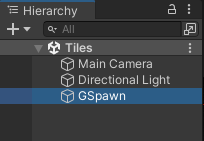
Note:You will need to perform this step for each scene in your project. So when you are done with one scene, and would like to create a new scene, you need to click on Tools > GSpawn > Initialize again.
The Inspector
When the GSpawn object is selected, the Inspector will show a few toolbars:
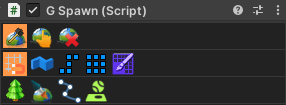
The top toolbar has 3 buttons. Pressing one of these buttons will activate a new mode of operation. The different modes of operation, listed from left to right, are:
Object Spawn - spawn objects in the scene using different spawn tools;
Object Selection - select objects and manipulate them using different tools;
Object Erase - erase objects using different erase tools;
In the image above, the first button is active which means object spawn mode is active. The toolbars sitting below the top toolbar contain different buttons that activate different spawn tools.
Clicking on these buttons will change the Inspector UI to contain the settings/controls that are specific to the tool you are using.
Same UI-Different Settings
You will notice while working with the plugin, that some settings appear in multiple places. For example, Modular Snap and Mirror Settings are used by different tools and you will see their UIs appear in different contexts. It is important to remember that each UI is mapped to a unique instance of those settings. That means that these settings are not shared. For example, Modular Snap settings appear in the UI when working with the Modular Snap Spawn, Modular Walls Spawn, Segments Spawn, Box Spawn and in Object Selection mode. However, each of these tools/modes use their own copy of those settings. Making changes to the snap settings in one context, doesn’t affect the other settings.
Prefab Management
In order to use the plugin functionality, you need to specify the prefabs you are going to use.
In GSpawn, prefabs are organized in prefab libraries. Each prefab library can contain a certain category of prefabs.
In order to setup your prefabs, you need to open 2 windows: Prefab Library and Prefab Manager windows.
To open the Prefab Library Manager window:
open Tools > GSpawn > Windows > Prefab Library Manager…
To open the Prefab Manager window:
open Tools > GSpawn > Windows > Prefab Manager…
You can then dock these windows anywhere you wish. The next image shows these 2 windows docked next to each other:
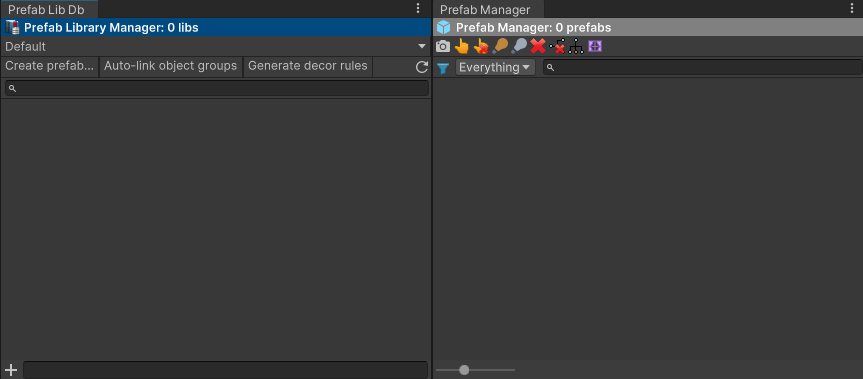
Creating Prefab Libraries
Dropping Prefab Folders
The easiest way to create prefab libraries and populate them with prefabs is by dropping prefab folders in the Prefab Library Manager window. Simply select a folder that contains prefabs and then drag and drop it onto the blank area inside the Prefab Library Manager.
The next image shows the state of these 2 windows after a prefab folder has been dropped inside the prefab library window:
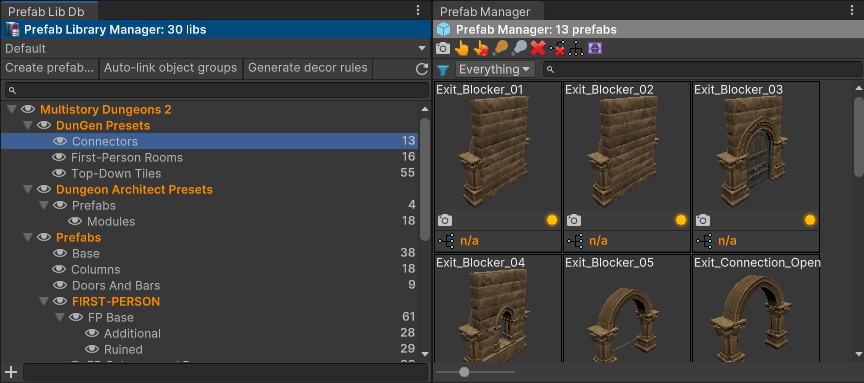
The folder Multistory Dungeons 2 was dropped in the prefab library manager and the plugin has created a hierarchy of prefab libraries that resembles the folder structure. Any folders that are empty or which don’t have any child folders that contain prefabs, are excluded.
The orange tinted libraries are empty, but they contain child libraries that contain prefabs. When a library contains prefabs, the number of prefabs will be shown to the far right of the library name.
Clicking on a prefab library will update the Prefab Manager window which will show a preview with all the prefabs that exist in that library. You can select multiple libraries at once by holding down [CTRL] when clicking. The prefab manager will always show the contents of all selected libraries.
Note:It is recommended that you try to keep the number of prefab libraries under control. When you use Undo/Redo, the plugin needs to refresh the UI and this can cause small lags if the number of libraries gets too large.
Manual Library Creation
You can also create libraries manually by entering a name in the bottom most text field and then clicking on the plus icon. In order to populate a library that was created manually, you must select prefab assets in the project view and then drop them inside the Prefab Manager window.
Library Visibility
Each library has an eye icon to the left of its name. Clicking on this icon will allow you to toggle the visibility of the library. When a library is visible, its prefabs will show up in the prefab manager. When invisible, its prefabs will be hidden. This can be used as a filtering mechanism.
If a library is hidden, all its child libraries will also be hidden.
Moving/Copying Prefabs Between Libraries
You can copy prefabs from one library to another using the following steps:
select prefabs in the prefab manager;
press [CTRL + C];
select the library (or libraries) where you would like to copy the prefab;
press [CTRL + V];
OR
select prefabs in the prefab manager;
hold down [ALT];
drag and drop the prefabs into the destination library;
You can also copy entire libraries:
select the libraries you wish to copy;
press [CTRL + C] (the libraries will turn green);
select the destination library (or libraries);
press [CTRL + V];
In order to move prefabs from a library to another library, follow the next steps:
select prefabs in the prefab manager;
drag and drop them in the destination library;
Prefab Previews
Prefab previews can be rotated by holding down the middle mouse button and moving the mouse. macOS users have the option of using an alternative shortcut: [ALT + right-click] and drag the mouse. This can be enabled from Edit > Preferences > GSpawn > Input under the macOS section.
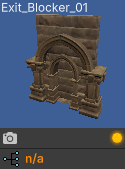
At the top of the preview you can see the name of the prefab asset.
The first row at the bottom, contains a small camera button which will reset the preview rotation back to 0 and a small yellow glowing button which will highlight the prefab asset in the project window.
The second row at the bottom informs you whether or not the prefab is linked to an object group.
Prefab Library Profiles
It is possible to organize your prefab libraries into prefab library profiles. Profiles are used in many places in the plugin. They are essentially a way to quickly switch between different configurations of settings/data. With respect to prefab libraries, you could for example, have a library profile that you use in one scene and a different profile that can be used in a different scene. There can only be one active profile and the prefab library will only show the libraries of the active profile.
Creating a Prefab Library Profile
In order to create a new library profile:
in the prefab library manager window, click on the top-most drop-down menu (initially it will contain a single item called Default);
then click on Create new profile…
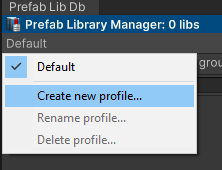
a new window will appear:
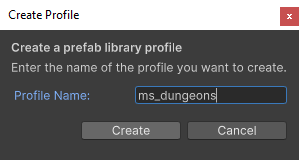
enter a name for the profile and click on Create.
The new profile will be marked as the new active profile:
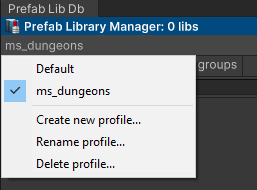
You can now populate the profile with libraries and prefabs using the methods discussed previously.
Object Spawn Tools
The following spawn tools are available:
The Spawn Guide
Some of the spawn tools work by creating a spawn guide object in the scene which you can move with the mouse cursor in order to establish the spawn location. The spawn guide is simply an indicator of where the next object will be placed.
The following spawn tools use a spawn guide as indicator:
Modular Snap Spawn;
Modular Walls Spawn;
Segments Spawn;
Box Spawn;
Props Spawn;
When using any of the tools mentioned above, you need to double-click on a prefab in the prefab manager window in order to create a spawn guide. Then, move the mouse in the scene to establish a spawn location. Left click to spawn.
Note: The way the spawn guide is moved in the scene with the mouse depends on the active spawn tool. For example, in Modular Snap Spawn, the guide will be snapped to the grid. In Props Spawn, it will be snapped to mesh or terrain surfaces.
Spawn Guide Rotation
You can rotate the spawn guide using the following hotkeys:
[X] - rotate around grid X axis;
[Y] - rotate around grid Y axis;
[Z] - rotate around grid Z axis;
All the hotkeys above will use the spawn guide pivot as the rotation pivot. If you wish to use the spawn guide bounds center as the pivot, you have to also hold down [SHIFT] while pressing the X/Y/Z buttons.
You can press [I] to reset the object rotation to the rotation stored in the prefab asset
When rotating the spawn guide with these hotkeys, the default rotation is 90. If you wish to change the rotation step, open Edit > Preferences…
This will open Unity’s Preferences window. In the left pane, click on Input under the GSpawn parent item:
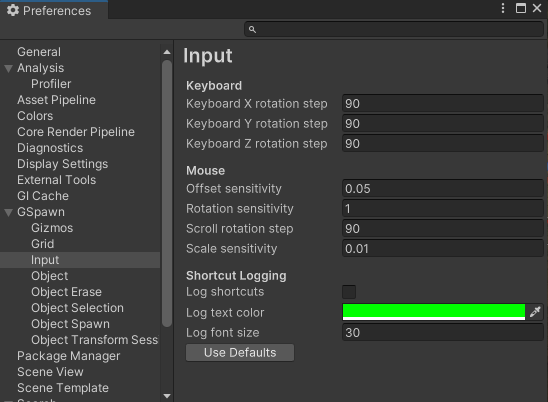
You can now change the keyboard rotation step for each axis individually.
Picking Prefabs From Scene Objects
Instead of double clicking on prefab previews in the prefab manager to change the spawn guide prefab, you can also pick prefabs from the scene directly. This is much faster instead of searching through prefabs in the manager.
Simply hold down [ALT] and left click on a scene object.
Note:This only works as long as the object you click on is an instance of a prefab that exists in the prefab manager.
Modular Snap Spawn

Modular snapping represents the act of snapping objects to the scene grid. When this spawn tool is active, the spawn guide will be snapped to the grid as you move the mouse. When you left click, a new object will be spawned in the scene. This allows you to populate your environment by placing one object at a time.
Note:Although Modular Snap is a spawn tool, modular snapping is actually used in different places. Other spawn tools such as Modular Walls, Segments and Box also use modular snapping to snap the spawn guide. Also the Object Selection mode uses modular snapping to snap selected objects which is very handy when making changes to the scene.
Moving Up/Down
It is sometimes useful to be able to move the spawn guide up/down. You can use the [Q] & [E] hotkeys for this purpose. They will move the spawn guide down & up respectively. The amount of movement is the same as the grid cell size along the Y axis.
The same can be achieved if you hold down [CTRL + SHIFT] and use the mouse scroll wheel to offset the guide.
Press [R] in order to reset the offset back to 0.
Y Axis Rotation
In Modular Snap, you can rotate the spawn guide by holding down [SHIFT] and using the mouse scroll wheel. This is in addition to the X/Y/Z hotkeys discussed earlier.
Grid Snap Climb
Moving up/down using hotkeys or mouse scroll wheel is flexible, but sometimes you may desire a more automatic behavior. This behavior is called grid snap climb and you can find the associated field in the Inspector:

You can also toggle grid snap climb on/off using [SHIFT + C].
When grid snap climb is active, the spawn guide will ‘climb’ objects in the scene and it will also be snapped to the grid. This works really well for objects that are supposed to sit on top of other objects (e.g. walls on top of floors, decorative elements on walls etc).
Object-to-Object Snap
Modular snapping has 2 modes of operation: grid snap (which we already discussed) and object-to-object snap. You can switch between these 2 by pressing [S].
When object-to-object snap is active, the spawn guide will no longer snap to the grid. Instead, it will snap to nearby objects.
Note:Object-to-object snapping doesn’t work well with prefabs that have bumps or decorative elements on the sides. It is ideal when working with walls, floors or any other similar structures that have flat side-surfaces. And it is especially suited for working with tile blocks (i.e. cubes).
Alignment Highlights & Hints
When snapping objects, you will usually want to be precise and sometimes you may want objects to line up in a certain direction. When using a smaller grid cell size (e.g. 0.5 or 1) this can become difficult when objects are far apart because it is hard to tell wether their positions line up correctly.
The plugin assists you by highlighting nearby objects when they line up with the spawn guide along one of the grid axes. The next image shows an example of this:
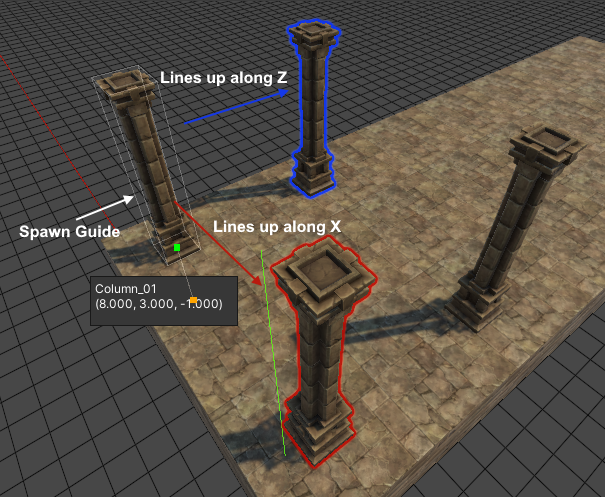
In the image above 3 columns have been spawned on top of a floor. The spawn guide has been placed in the corner and the highlights were used to ensure that it lines-up properly along the grid X and Z axes.
In conjunction with the alignment highlights, the plugin can also give you alignment hints which are labels attached to nearby objects. Only those objects that line-up with the span guide will display alignment hints.
In the image below, the hint labels were used to spawn 3 successive equally spaced columns:

The labels show the name of the object to which they are attached and a distance value. This distance value represent the distance from the spawn guide. In this example, the columns were spawned from left to right at a distance of 6 units from each other. By spawning each new column at a distance of 6 units away from the previous one, we can ensure that all columns are equally spaced.
Although very handy in certain scenarios, the highlights and especially the labels can sometimes get in the way. You can toggle these helpers using the following shortcuts:
[SPACE] - toggle alignment highlights;
[SHIFT + SPACE] - toggle alignment hints;
Prefs
There a few settings that that you can change from the preferences window when it comes to alignment highlights and hints. Open Edit > Preferences… and in the left pane click on GSpawn > Object Transform Sessions:
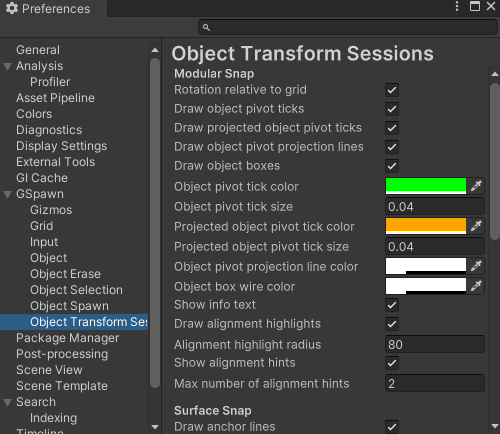
Under the Modular Snap section you have different settings that can be modified that affect modular snapping. We will talk about those that are related to alignment highlights and hints:
Draw alignment highlights - toggle alignment highlights. Hotkey: [SPACE];
Alignment highlight radius - this number represents a world radius that is used to collect nearby objects that will be checked for alignment. Use bigger numbers to cover larger distances, although the default value should be more than enough in most cases;
Show alignment hints - toggle alignment hints. Hotkey: [SHIFT + SPACE];
Max number of alignment hints - the maximum number of hint labels that will be shown in the scene view. For example, a value of 2 means that if there are 10 objects that line up with the spawn guide, only 2 of them will have hint labels shown in the scene view. A smaller number is generally desired in order to avoid clutter;
Grid Snap Axis Lock
When snapping to the grid, it may sometimes be useful to lock the movement of the spawn guide along a single direction (i.e. one of the grid’s axes, either the X or Z axis). You can do that by holding down the [CTRL] key:
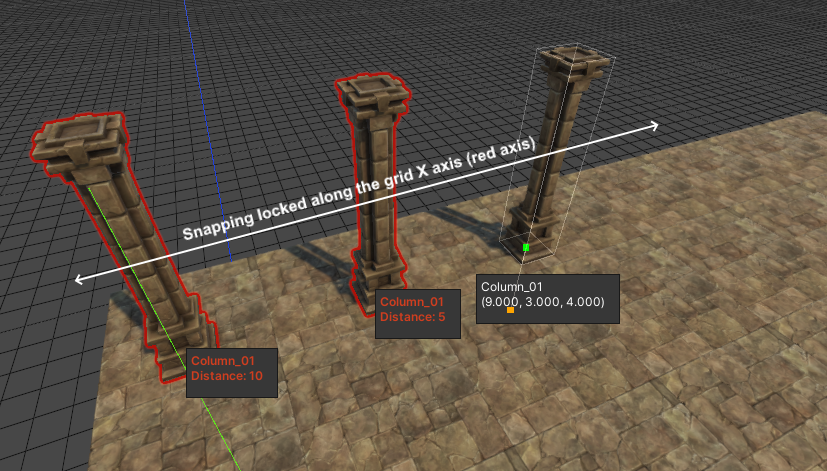
In the image above the [CTRL] key is held down and the spawn guide con only move left or right when moving the mouse. In this manner you can easily ensure that it lines up with the other columns.
The plugin will pick the axis that runs horizontally across the screen. In the image above it just happens that this is the grid X axis. You can however, hold down [CTRL + SHIFT] to change the axis. In the previous example, this would change the lock axis so that it corresponds to the grid Z axis (blue axis).
Modular Walls Spawn

This spawn tool is very handy for creating walls. You could use Modular Snap Spawn to place one wall piece at a time. However, a faster approach would be to use Modular Walls Spawn which can spawn multiple wall segments in a few clicks while also handling inner and outer corners automatically.
Modular Wall Prefab Profiles
Before this tool can be used there is a bit of setup involved. If we take a look in the Inspector, we can see the following settings:
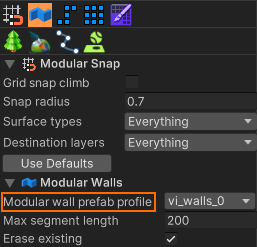
We can see that we need to specify a Modular wall prefab profile. This is a prefab profile that contains the necessary data which will be used by the plugin to spawn wall pieces.
Open Tools > GSpawn > Windows > Modular Wall Prefabs…
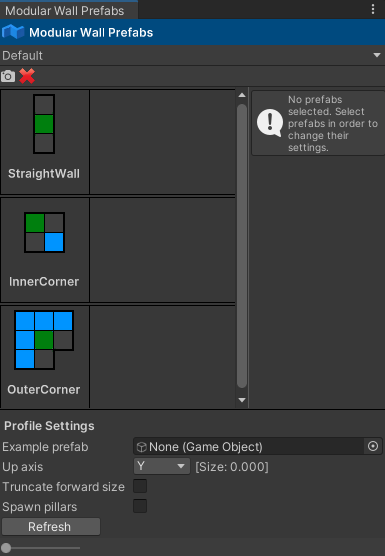
The above window will show up on the screen and this is where you need to specify the necessary data.
Wall Pieces
In the left pane you can see there are 3 icons that represent different types of wall pieces. Let’s talk about what each of these mean:
Straight Wall - a straight wall piece is simply a regular wall piece that connects to 2 other adjacent wall pieces;
Inner Corner - an inner corner piece is used when the wall makes a turn and the corner points towards the inside of the area surrounded by the wall;
Outer Corner - an outer corner piece is used when the wall makes a turn and the corner points towards the outside of the area surrounded by the wall;
The following image shows the 3 prefabs that will be used in this example, each prefab being mapped to each of the wall pieces we just discussed:
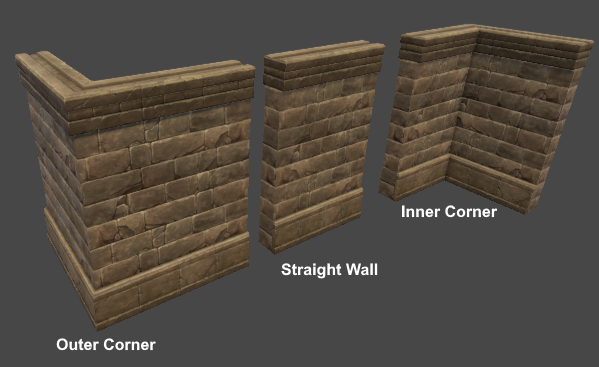
Profile Settings
At the bottom of the modular wall prefab window, there is a section labelled Profile Settings.
The first field is the most important and is called Example prefab.
The Up axis field allows you to specify the prefab local axis that points up. This will usually be the Y axis.
The field Truncate forward size is used in situations where the walls have small bumps at the sides where they connect to adjacent pieces. If these bumps exist, this toggle has to be checked, otherwise gaps can appear between the wall pieces.
The Spawn pillars toggle allows you to work with pillars.
Example Prefab
An example prefab is a prefab that you need to create that contains all the necessary wall pieces arranged in a certain configuration that will allow the plugin to detect how the wall pieces fit together.
In order to create the example, prefab follow the next steps:
switch to Object Selection mode;
find the Straight Wall piece in the prefab manager and drag and drop it in the scene. As soon as you release the left mouse button the object will start snapping to the grid. Left click to commit;
make sure that the Straight Wall piece uses a rotation of 0 on all axes. This is important;
spawn the Inner and Outer wall pieces in the scene using the same approach and connect them to the Straight piece. These can be rotated as necessary;
spawn 2 other Straight wall pieces (you can use [CTRL + D] to duplicate the first one) and connect them to the Outer and Inner corners respectively;
The next image shows how this arrangement looks like for the prefab assets that we are using in this example:

The labels associated with each wall piece are not random. They have special meaning. We’ll get back to this in just a bit.
Select the wall pieces you just created and inside the Prefab Library Manager window click on the Create prefab… button in the top toolbar:

This will bring up the following window:
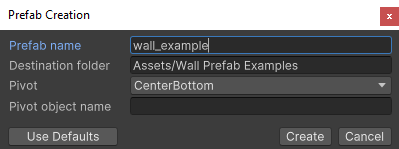
You need to give the prefab asset a name and specify a destination folder. You can drag and drop the folder in the Destination folder field. The other fields are not important in this case.
Click on Create. If a prefab with the same name already exists, you will be asked if you wish to replace the old prefab.
Now click on the prefab asset you just created. And open the prefab:

Once the prefab window is open, click on each wall piece and assign it the right name as discussed earlier:
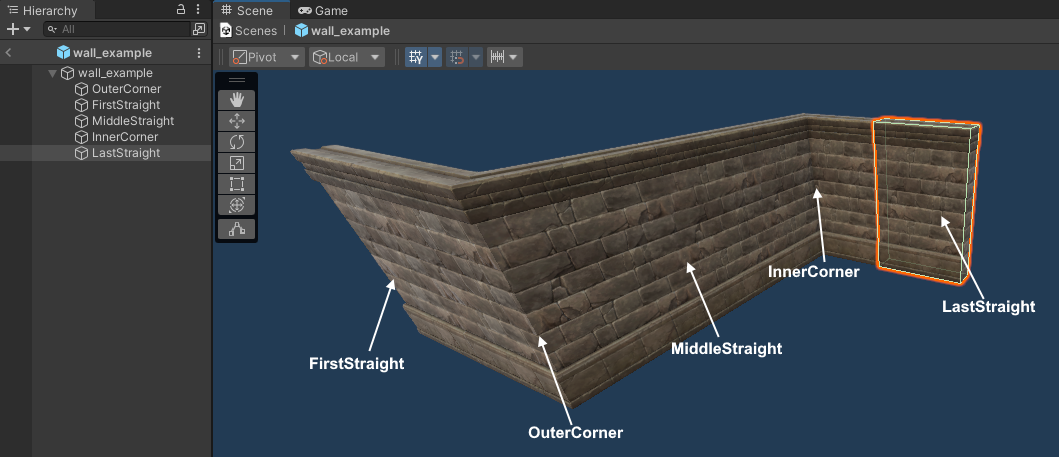
These names are important to the plugin because it allows it to identify the role of each piece. The names can be lower case, upper case or mixed. The important thing is that the names should spell exactly as shown in the image above.
Finally, drop the prefab asset inside the Example prefab in the Modular Wall Prefab Profile window:
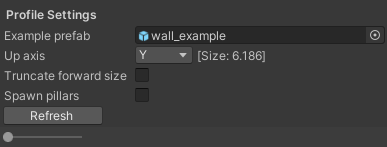
If there are any errors with the prefabs (e.g. incorrect naming) the plugin will show an error message in the console window.
If you ever need to make changes to the example prefab, you have to press the Refresh button to instruct the plugin to refresh the data.
Assigning Prefabs
The final step is to assign the wall piece prefabs to the correct slot in the wall prefab profile window as shown in the image below:
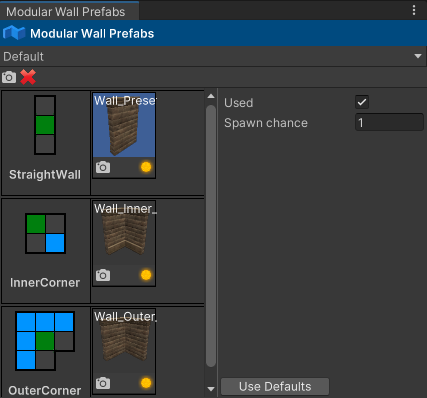
Each wall piece was assigned to the right slot (Straight Wall, Inner Corner & Outer Corner) by dragging a prefab from the Prefab Manager window into the left pane next to the corresponding slot.
At this point, the prefab profile is ready to use.
Note:If you need more than one profile, you will have to create an additional profile and a new example prefab for each profile. In this example, a single profile is needed and the Default profile was used.
Spawning Walls
Make sure the Modular Walls spawn mode is active. Select the wall prefab profile you would like to use in the Modular wall prefab profile field.
Double-click on any prefab in the prefab manager (any prefab will do). The plugin will create the spawn guide from the Straight Wall piece associated with the current profile.
To spawn:
snap the spawn guide into the right position where you would like to place the wall. Note:The plugin will always keep the spawn guide’s up axis aligned to the grid. This means you can’t rotate the spawn guide around X or Z. Only the Y hotkey will work;
left click to start. This will disable the spawn guide and box indicators will appear to approximate the wall pieces;
each successive click will add 2 perpendicular wall segments;
when the entire wall plan has been established, hold [SHIFT] and left-click to commit;
While laying down wall segments, you can hold down [SHIFT] and right-click to step back (i.e. remove the last 2 wall segments). You can also press [ESCAPE] to cancel.
The next image shows a wall that surrounds a floor plan:
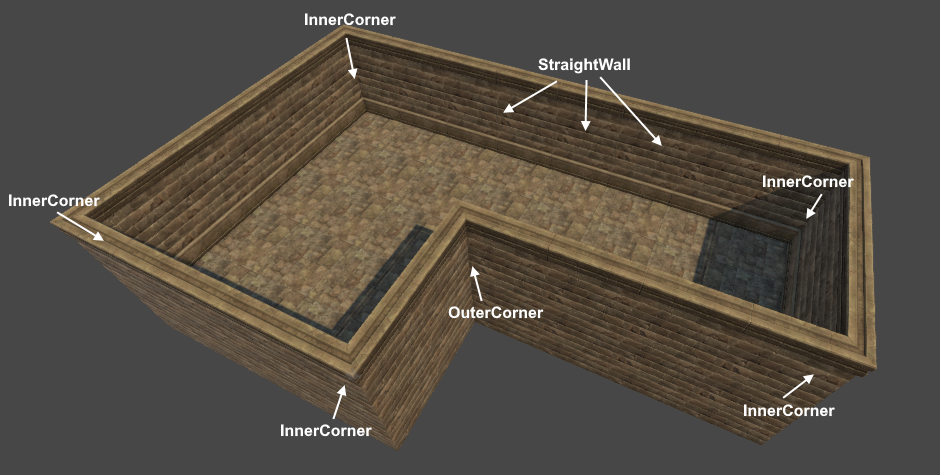
As you can see, even though there is a setup phase, once the setup phase is finished, spawning walls can be done in a matter of a few clicks with support for inner and outer corner detection.
Multiple Prefabs Per Wall Piece Slot
You can assign more than one prefab to the same slot as shown in the image below:

In the image above a damaged wall piece was added to the Straight Wall slot. Two damaged prefabs were added to the Inner Corner slot. The spawn chance field has been set to 0.3 for all damaged prefabs.
The result can be seen in the next image:
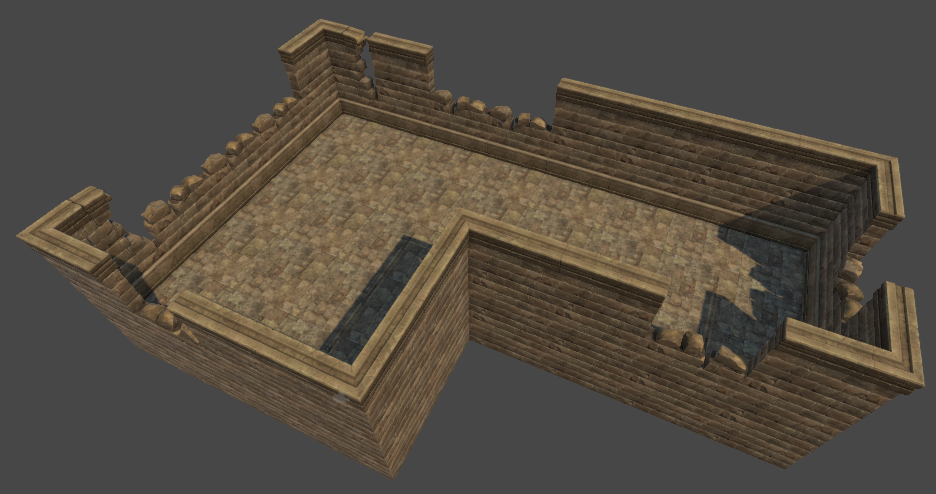
Note:This only works as long as all the prefabs which are assigned to a slot share the same pivot. For example, if you were to place all the Inner Corner wall pieces at the origin in the same rotation, the wall pieces would perfectly overlap.
Spawning Walls With No Inner/Outer Corners
If you would like to spawn walls that don’t have Inner/Outer corners, you can do that by following the next steps:
create the example prefab as shown in the image below:
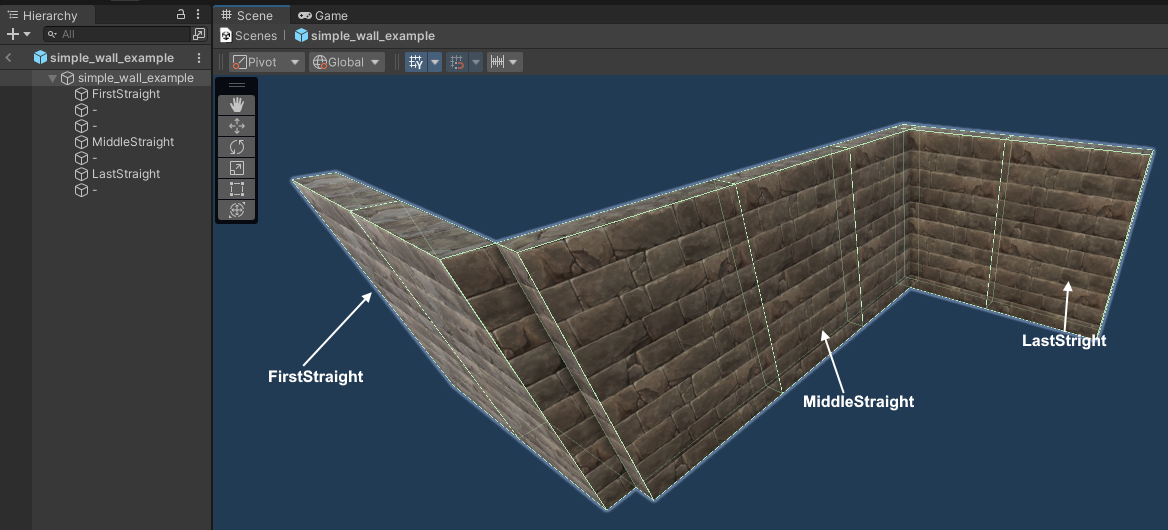
Note that in this case, because we don’t have access to inner and outer corners, 2 straight wall pieces were used to create them. However, in this case, these pieces don’t have to have a specific name. In fact, their name can be anything except for the recognized names. In this example, the name assigned to these objects was ‘-’.
assign the example prefab to the Example prefab field;
in the wall prefab profile window, assign the straight wall piece to the Straight Wall slot; Inner & Outer slots have to be kept blank;
The next image shows an example of spawning walls using this new wall profile:

Spawning Arches
You are not limited to spawning walls only with this tool. For example, the next image shows how this spawn tool was used to spawn arches:

The left image shows the example prefab and the right image shows the final result.
Spawning Pillars
You can also spawn pillars that sit between the different wall pieces. The next image shows an example of spawning railings with pillars:
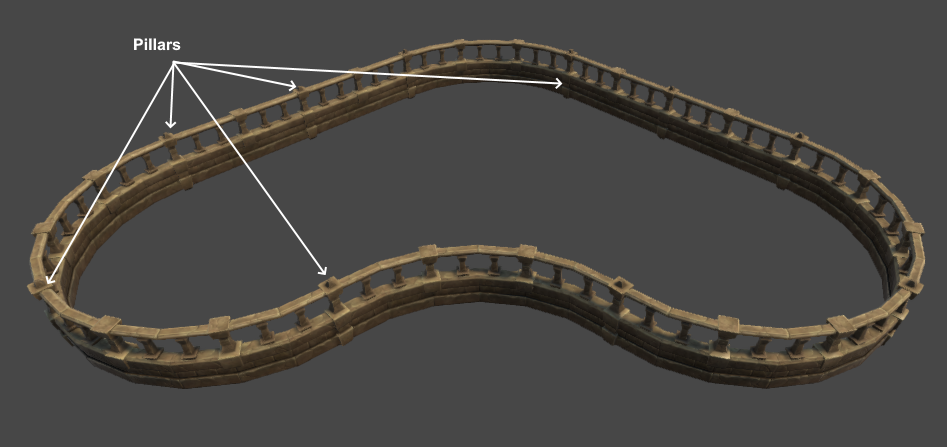
In order to support pillars, you will need to add 4 pillar objects to the example prefab. The next image shows the example prefab that was constructed for the railing example above:
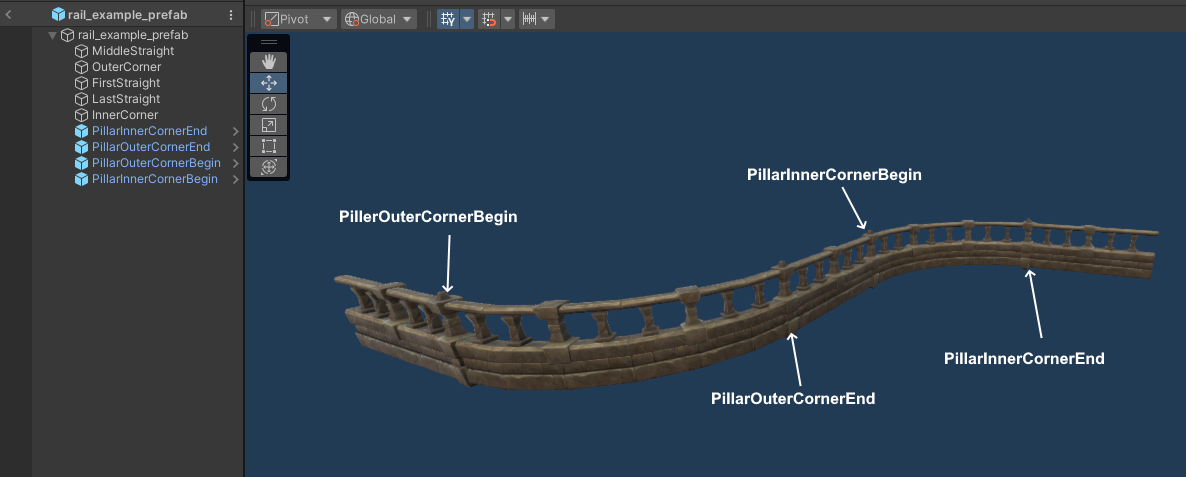
There are 2 pairs of pillars that have to be added to the example prefab:
at the beginning and the end of the outer corner (PillerOuterCornerBegin & PillerOuterCornerEnd);
at the beginning and the end of the inner corner (PillerInnerCornerBegin & PillerInnerCornerEnd);
Note:Don’t forget that the names are important. Case doesn’t matter, but the name has to be spelled exactly as it is shown in the image above.
Next, you need to check the Spawn pillars toggle in the wall profile settings and select a random prefab profile that contains the pillar prefabs:
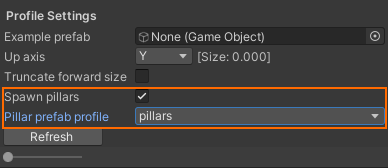
At this point you are ready to spawn walls/railings with pillars.
Another category of pillars that can be used is pillars that is in the middle of the inner and outer corners as shown in the image below:
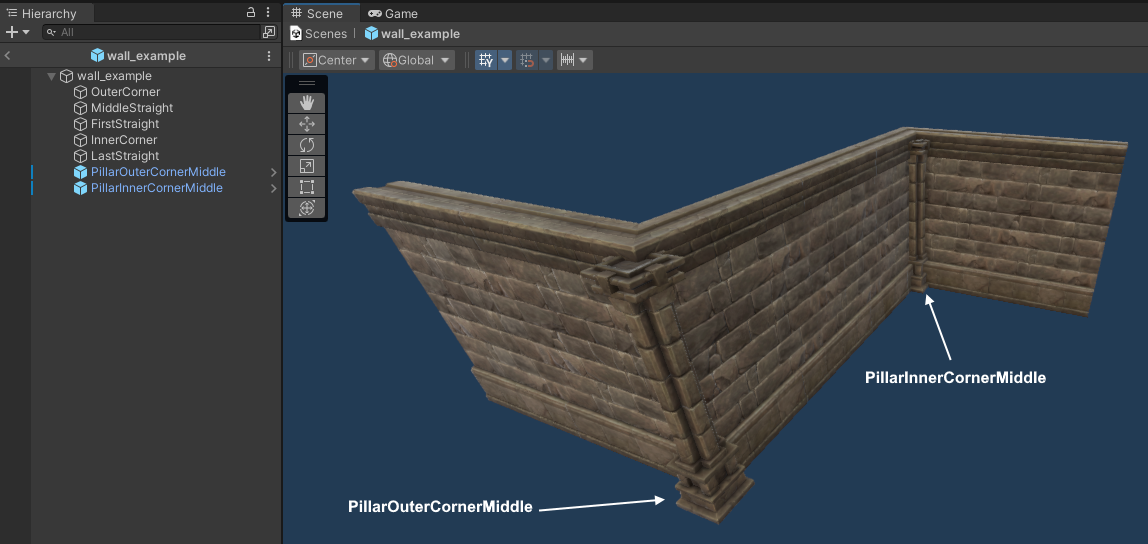
2 pillar objects have been used in this case:
one pillar called PillarOuterCornerMiddle sitting in the middle of the outer corner;
one pillar called PillarInnerCornerMiddle sitting in the middle of the inner corner;
In the image above, the same prefab was used for both pillars. However, you could have 2 different prefabs for each corner. In that case, you need to assign a tag to each pillar prefab. The PillarOuterCornerMiddle pillar must have a tag with the same name. Same for the PillarInnerCornerMiddle. Both pillars have to be assigned to the pillar random prefab profile.
Requirements
In order to use the Modular Walls spawn tool, the following conditions must be met:
the straight wall piece must be larger along the connection axis than it is along its inner axis (e.g. don’t use cubes);
when creating the example prefab, the MiddleStraight piece must have a rotation of 0 for all axes;
all wall prefab pieces must have the same up axis (i.e. if you set the rotation of all wall piece prefabs to 0 on all axes, they must all point up along the same axis);
all wall pieces and pillars must have a scale of 1 for all axes;
all pillars except for the PillarOuterCornerMiddle & PillarInnerCornerMiddle must be rotation independent. This means, the pillars must look ‘right’ regardless of what their rotation is in the example prefab;
when using wall profiles with inner and outer corners, you should avoid situations where you create a turn immediately after a corner piece. This can create overlaps or gaps in the wall. The next image shows an example of this situation:

Reusing Example Prefabs
Some asset packs contain different types of walls. They wall prefabs look different, but the walls connect to each other in the same manner. In this case, it is possible to reuse the same example prefab between different wall profiles.
For example, the following example prefab can be used to create walls for a village interior basement:

But using the same example prefab, different types of walls can be created:
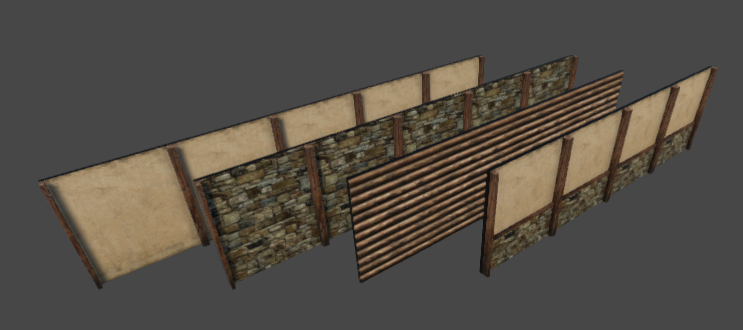
Note:You still need to create a new wall prefab profile for each type of wall, but the example prefab can be reused between profiles.
Segments Spawn

Segments Spawn and its cousin Box Spawn are very handy when working with tile blocks. They can also be used when laying down floors in modular environments. In fact, the floor prefabs that you saw in the Modular Walls Spawn chapter images were spawned using Box Spawn.
In order to use Segments Spawn, make sure the tool button is active in the Inspector as shown in the image above.
Double-click on a prefab in the prefab manager to activate the spawn guide. This will enable modular snap and you can move the spawn guide around in the scene and snap it to the grid just like you can do with other spawn tools that use snapping.
In order to spawn, follow the next steps:
left-click to start (this will disable the spawn guide and show box indicators instead);
each successive click adds 2 new perpendicular segment pairs;
hold down [SHIFT] and left-click to commit and spawn;
You can hold down [SHIFT] and right-click to step back (i.e. remove the last 2 segments) if you make a mistake.
The next image shows a simple example of a series of tile blocks spawned using this tool:

Extension Plane
When the spawn guide is created, you will see a transparent quad sitting below the spawn guide:

This is the extension plane and it is also used in Box Spawn mode. The extension plane represents the horizontal extension direction. This simply means that the segments chain (or box for Box Spawn) will extend along the surface of this plane.
The height of the segments chain (or box for Box Spawn) will extend perpendicular to this plane.
You can cycle through different plane orientations by holding down [CTRL] and using the mouse scroll wheel.
You can hold down [CTRL + ALT] and left-click to pick the orientation from the object under the mouse cursor or the grid. The plane will always be aligned with one of the spawn guide’s bounding volume faces. So, when picking the orientation via left-click, the extension plane will be aligned with the volume face that is most aligned with the surface you picked with the mouse cursor.
Note:Since the orientation of the plane is linked to the spawn guide’s volume faces, rotating the spawn guide will also change the orientation of the extension plane.
Height Modes
There are 3 height modes that allow you to change the height of the segment chain. Before we discuss these height modes it is important to talk about cell stacks. Each segment is a collection of cell stacks that extend along a certain direction. Each cell stack can have a different number of cells. The number of cells in a stack is called the stack height. Objects will be spawned in each cell.
The available height modes are:
Constant - each stack has the same height value;
Random - each stack will have a random height in a specified interval;
Pattern - the height of each stack will be taken from an integer pattern;
The next image shows the height mode controls in the UI:

The Default height field allows you to specify a default height value that will be used when you start a segment chain. The Raise/Lower amount fields allow you to control how many cells are added/removed when changing the height using the scroll wheel.
The 3 fields (Default height, Raise amount & Lower amount) apply to all height modes. For the Random and Pattern modes, the default height acts as a base height value.
The following image shows an example of tiles spawned using each one of these height modes:
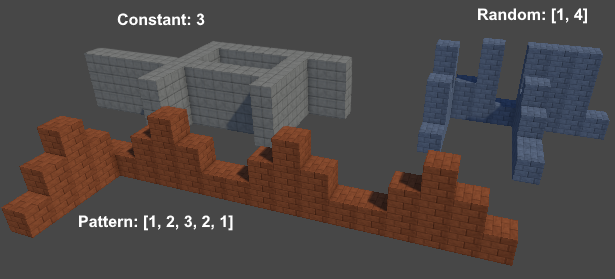
You can change the height by holding down [SHIFT] and using the mouse scroll wheel. When using the Random and Pattern modes, this will essentially allow you to apply a base height value to the generated height values.
Prefab Pick Mode
By default, when you spawn objects using the Segments Spawn tool, the objects will be spawned from the same prefab used by the spawn guide. But it is possible to randomize the prefabs that are used during spawn.
In the segments spawn settings UI, there is a field called Prefab pick mode. The following options are available:
Spawn Guide - the objects will be spawned from the prefab associated with the spawn guide (the one you double-clicked in the prefab manager window to create the spawn guide);
Random - the prefab will be picked from a random prefab profile;
Height Range - the prefab is picked from a integer range prefab profile;
The following image shows tiles which were spawned using the Random and Height Range pick modes:

Note:When using Random or Height Range, you should make sure all prefabs have the same size. Otherwise, you might encounter incorrect results.
Settings Profiles
The segment settings can be organized in profiles:

A Default profile is always available, but you could create more. This can be useful in situations where you need to switch between different configurations of settings. Having to change them manually each time you need to spawn tiles with a different strategy can be tedious. But if you organize the settings in profiles, you only need to select a new profile and the settings will automatically reflect the change.
Note:When changing settings, you actually make changes to the currently active profile.
Box Spawn

Box Spawn is another spawn tool which is useful when working tile blocks or when laying down floors.
In order to use Box Spawn, make sure the tool button is active in the Inspector as shown in the image above.
Double-click on a prefab in the prefab manager to activate the spawn guide. This will enable modular snap and you can move the spawn guide around in the scene and snap it to the grid just like you can do with other spawn tools that use snapping.
In order to spawn, follow the next steps:
left-click to start (this will disable the spawn guide and show box indicators instead);
left-click to spawn;
Box Spawn also supports the same height modes as Segments Spawn. Also, the same prefab picking strategies can be used.
Fill Modes
In Box Spawn there are 3 fill modes available:

The default fill mode is Solid. This simply means that the box area will be filled with objects.
The second fill mode is Border. When this fill mode is active, you can also change the box border. The next image shows a few examples of spawning tiles with different border size width values:
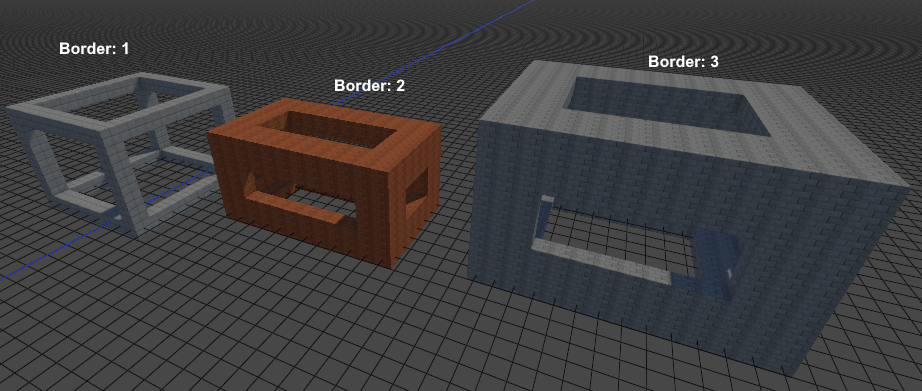
The next image shows the inside of the right most structure:
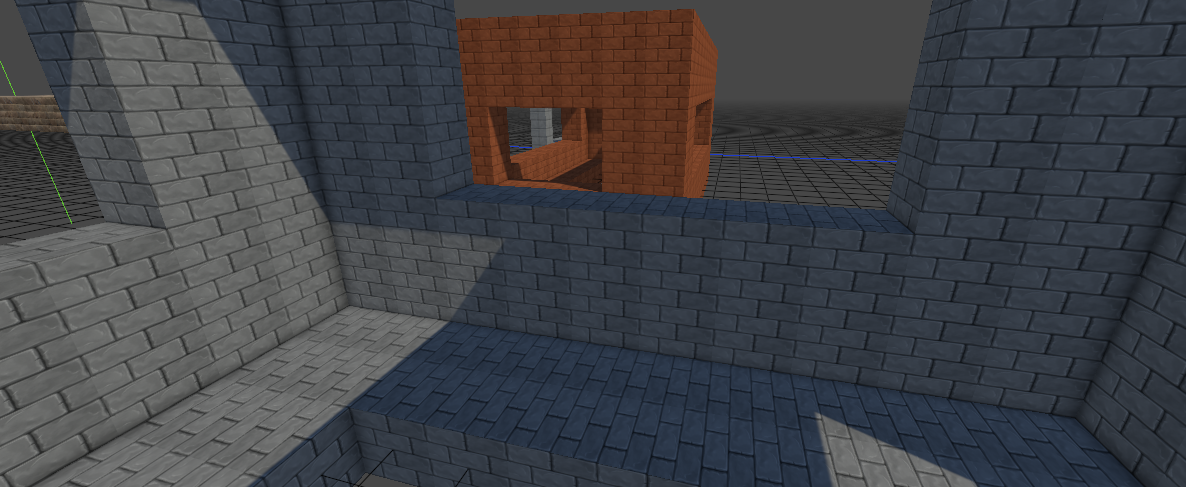
The third fill mode is Hollow. This essentially creates a hollow box volume. The next image shows the interior of such a structure:
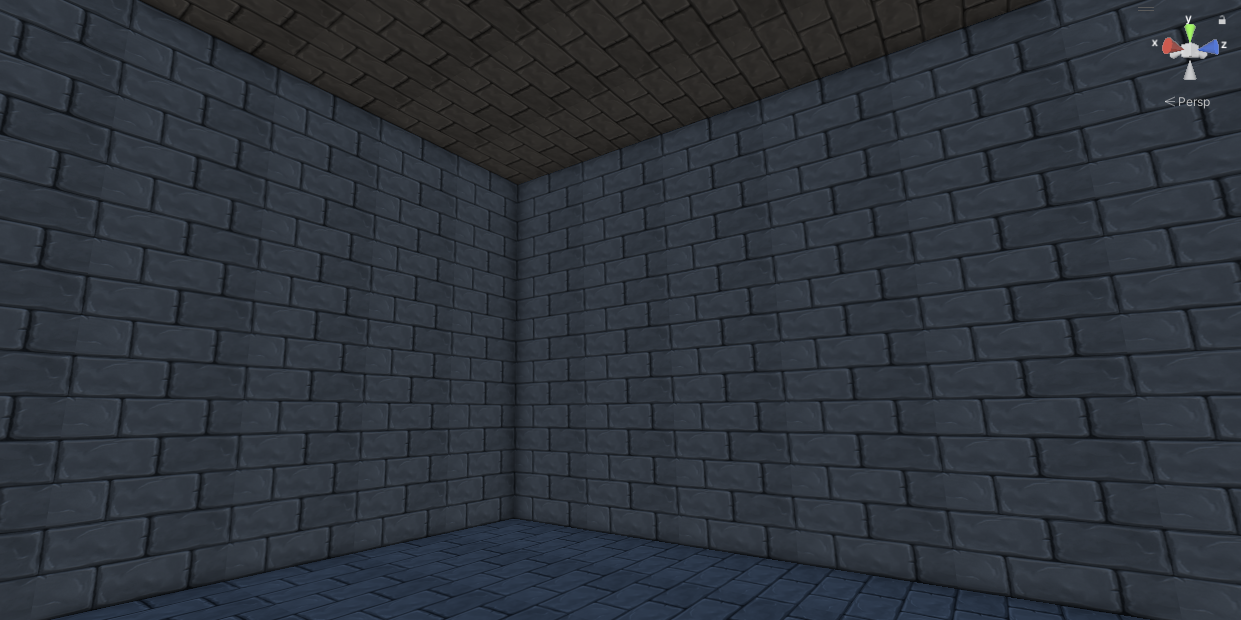
When working with tile blocks, this fill mode can actually be used as an optimization strategy. From the outside, the structures will look the same as when using the Solid fill mode. But on the inside they are empty. Which means fewer tiles to process/render etc.
This depends of course on the game’s needs. Sometimes it may be useful to use the Solid fill mode instead.
Tile Rule Spawn

The Tile Rule Spawn tool allows you to paint tiles inside an infinite grid. When tiles are painted, adjacent tiles are automatically updated based on a series of specified tile rules. These tile rules define the way each tile opens up (i.e. connects) to adjacent tiles.
In order to use this tool, the next steps have to be performed:
create the tile prefabs;
create a Tile Rule Prefab Profile;
populate the tile rule profile with tile rules which define the way in which the tile prefabs open up (i.e. connect) to each other;
create a tile rule grid;
paint;
The tile rule spawn tool will work with any modular prefabs that can be connected. If you can create a bunch of tiles that can connect to each other using Unity’s interface, you should be able to use those prefabs with the Tile Rule Spawn tool. There is an exception to this, namely walls. The tile rule system doesn’t handle inner and outer corners properly. So if you need to create environments where floors must have walls sitting on top, it is best to use a combination of Modular Snap Spawn and Modular Walls Spawn.
Note:After you paint an environment using Tile Rules, you can then populate it using Modular Snap Spawn or Props Spawn or any other spawn tool for that matter.
Creating Tile Rule Prefabs
Assuming you have an asset package that contains modular prefabs and you would like to create a bunch of tiles that can be used with the tile rule spawn tool. The easiest way to do this would be to follow these steps:
activate Object Selection mode;
from the prefab manager, drag and drop prefabs into the scene. When a prefab is dropped into the scene, it will automatically start snapping to the grid. Left-click to stop snapping. Press [D] to enable snapping again if you want to make changes. You can also use the move gizmo with [CTRL] held down to snap. Press [SHIFT + S] to snap the object to the grid along all axes;
snap each object in the right place;
press the Create prefab… button in the Prefab Library Manager window;
enter the name of the prefab and pick a folder;
set the pivot to TileRule and enter the name of the Pivot object name;
make sure the objects are selected click on Create;
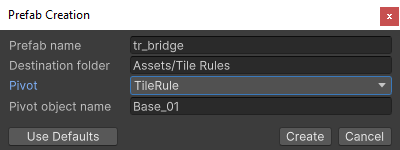
In the image above, the Pivot object name field was set to Base_01. The pivot object represents the main object in the tile. It is the object that will sit on top of the grid surface, usually a floor prefab. Decorations will usually be placed around this object. If you leave this field empty, the plugin will pick the object which has the greatest volume (the mesh bounding volume is used). This is ok in most situations, but if your tile is composed of different objects of similar sizes, you will have to enter the name of the pivot object in this field.
The next image shows an example of a tile prefab that was created:

The next image shows the tiles that were created for the purposes of this discussion:

The labels below each tile are simply conventions and try to describe the tile rule associated with each tile. For example, the Bridge tile connects 2 adjacent tiles along a certain direction. The Turn tile connects 2 adjacent tiles when they meet in a corner.
After all tiles have been created, make sure to add them to a prefab library so that they can be picked from the Prefab Manager.
Creating Tile Rules
A tile rule specifies how a tile connects to adjacent tiles. After the tile prefabs have been created and assigned to a prefab library, you have to create a tile rule profile. Open Tools > GSpawn > Windows > Tile Rules…
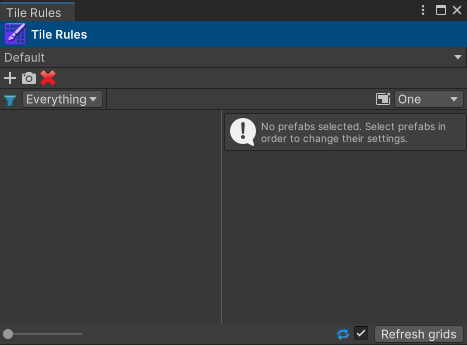
Use the topmost drop-down control to create a new profile. You can also use the Default profile if you wish.
A tile rule profile holds a collection of tile rules. Each tile rule can be associated with one or more prefabs.
In order to create a new tile rule, click on the left-most plus icon in the top toolbar. This will add a new tile rule in the left pane:
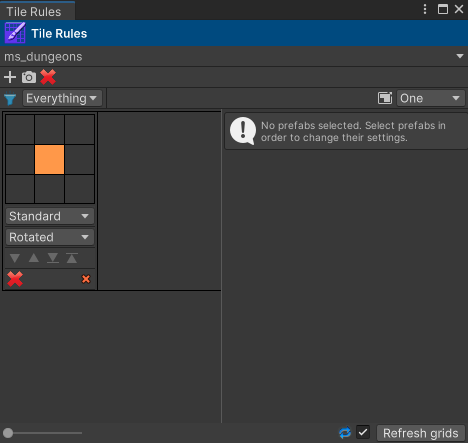
The small button grid allows you to define the rule. The middle button represents a tile that is painted inside the grid. The adjacent buttons represent its neighbor cells. If you left-click on one of the neighbor cells, it will turn green. When a tile is green, it means that the center tile opens up in that direction so a tile has to exist in that cell. If you right-click it will turn red. This means the center tile is closed off in this direction and no tile can reside in that cell. Gray cells are neutral (i.e. the rule doesn’t care if a tile exists in that cell or not).
In order to assign prefabs to a tile rule, you have to select prefabs in the prefab manager and drag and drop them inside the tile rule drop area:

Next you have to left/right-click on the tile buttons to define the rule. The next image shows the tile rules that were created for each of the 5 tiles we created earlier:
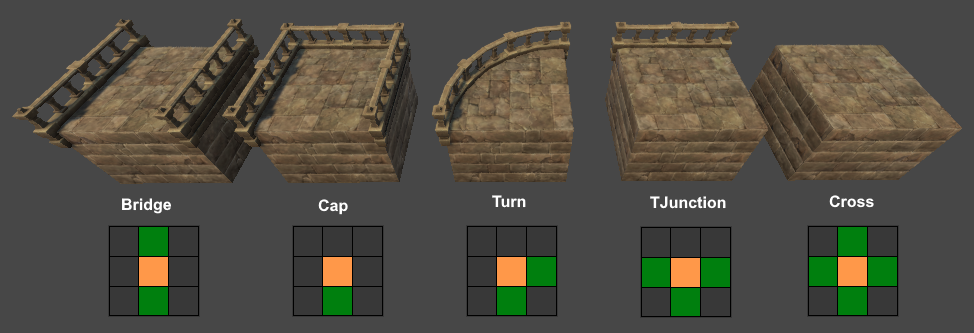
An important detail to remember here is that the coordinate system of the tile buttons in tile rule UI maps to the world axes as explained below:
the horizontal axis of the button grid maps to the world X axis;
the vertical axis of the button grid maps to the world Z axis;

So when clicking on the buttons to turn them green (or red) you first have to look at the tile objects and see where they open up and where they close off. In the image above, the tiles are lined up along the world X axis and the camera is looking roughly along the world Z axis.
The Bridge tile opens up along the Z axis, but is closed off along the X axis (the railings block the entrance). Therefore, the bottom and top tiles of the tile rule button grid were turned green.
The Cap tile opens up along the negative Z axis. Only the bottom tile was turned green in this case.
The Turn tile opens along the positive X axis and the negative Z axis. Therefore, the right and bottom cells were turned green.
The TJunction tile opens up along the X axis and along the negative Z axis. The left & right neighbors were turned green together with the bottom one.
The Cross tile opens up along the X and Z axes, so the horizontal and vertical neighbors were turned green.
Don’t forget that you can also right-click on the cell/tile buttons to turn the red. This allows you to be more specific. For example, if you wanted to have a variation of the Cross tile that only spawns when it is not surrounded by neighbors on the diagonal, you could define the rule like this:

This variant will spawn only if the tile is surrounded by tiles along the X and Z axes AND it doesn’t have any neighbor tiles along the diagonals.
Defining the tile rules may get a little bit of getting used to, especially if you haven’t used tile rules before. It may take some trial and error until you get the results you are after. Although we haven’t talked about painting yet, you should know that you can start painting tiles as soon as you have at least one rule defined. In this way, you can create a rule, create a grid, and paint a bunch of tiles for preview purposes and then see the grid update automatically when you add new rules or when making changes to existing rules. This makes it easy to spot mistakes early and make the necessary changes.
Creating a Tile Rule Grid
Once the tile rule profile is setup, you have to create a tile rule grid which will be used as a paint canvas.
Note:The tile rule grid should not be confused with the scene grid. They are different. When using the Tile Rule Spawn tool, you will be painting on the tile rule grid. When using Modular Snap Spawn or other tools that use modular snapping, you will be snapping to the scene grid.
Make sure the Tile Rule Spawn tool is active. Find the Tile Rule Grid Creation section and fill in the settings:
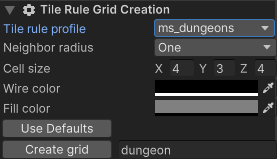
The mandatory fields are the following:
Tile rule profile - the tile rule profile you created. This could be the Default profile if you chose not to create a new profile. In this example, the name of the tile rule profile is ms_dungeons;
Cell size: the grid cell size. For the prefabs we have been using in this example, the cell size is <4, 3, 4>. In order to find out the grid cell size, you have to know the size of the pivot object (the main object that defines a tile). This is usually a floor prefab. You can hover a prefab preview in the Tile Rule Profile window in order to find its size:

Just make sure to pick a prefab without decorations on the side. If you don’t have one, then pick any prefab, and truncate the values. For example, if the values show <4.023, 3.1200, 4.08> then you can use the size <4, 3, 4>.
Give the grid a name (in this case dungeon) and click on the Create grid button. This will create a game object in the scene with the same name. When painting tiles, all tiles will be spawned as children of this object.
Also, if you take a look in the Inspector, you will see that a tile rule grid item was added to the grid list:

You can have multiple grids in the same scene. The plugin uses the concept of current grid to establish the grid that is used as a paint canvas. You can click on a grid in the grid list to mark it as the current grid. The current grid is shown in green.
The next image shows the meaning of the controls which are associated with the tile rule grid item:

If you click on the left most arrow you can expand the UI:

From here you can change the grid origin and its rotation. This will actually change the position and rotation of the grid object in the scene.
The last few controls allow you to enable/disable mirroring, toggle mirror planes and move the mirror gizmo to a specified grid cell.
Tools & Brushes

If you look in the Inspector, you will see these 2 toolbars when the Tile Rule Spawn tool is active.
The first toolbar allows you to select the current tool. There are 4 tools available:
Paint [Q] - paint tiles using different types of brushes;
Ramp Paint [W] - paint ramps;
Erase [E] - erase tile using different types of brushes (can also erase non-tiles, that is objects spawned with other spawn tools if the Erase foreign objects toggle is checked in the Inspector);
Connect [R] - connect pairs of cells in the grid;
The second toolbar allows you to select the current brush. There are 3 brushes available:
Box Brush [SHIFT + Q] - paint tiles using a box brush. Left-click & drag to spawn tiles;
[CTRL + scroll wheel] - change horizontal size;
[SHIFT + scroll wheel]- change height;
[CTRL + ALT + scroll wheel] - move up/down;
Flexi Box Brush [SHIFT + W] - similar to box brush, but instead of changing the horizontal size using the scroll wheel, you change it by moving the mouse. Left-click, move the mouse to establish the size, then left-click again to spawn;
[SHIFT + scroll wheel]- change height;
[CTRL + ALT + scroll wheel] - move up/down;
Segments Brush [SHIFT + E] - spawn tiles along line segments. Left-click to start, move the mouse to establish the segment end-point, left-click to add a new segment, [SHIFT + left-click] to spawn.
[SHIFT + scroll wheel] - change height;
[CTRL + ALT + scroll wheel] - move up/down;
Note:When the Ramp Paint tool is active, only the Box Brush can be used and it will always have a horizontal size and height of 1.
By default, the brushes will snap to the tile hovered by the mouse cursor. This is useful in order to avoid using the [CTRL + ALT] hotkey all the time when you wish to move up and down. When painting, the brush will snap adjacent to the tile and when erasing, the brush will snap to the actual tile position.
If you wish to disable this automatic snapping behavior, you can uncheck the Snap to tiles toggle in the Inspector:
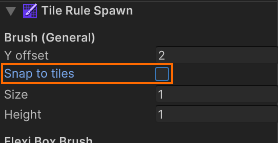
The next image shows a simple dungeon environment which was painted using a combination of Box and Flexi Box brushes:
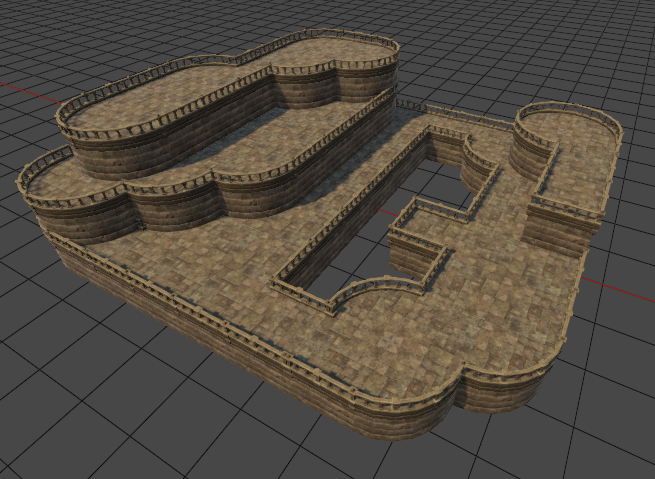
The next image shows a simple example of using the segments brush:
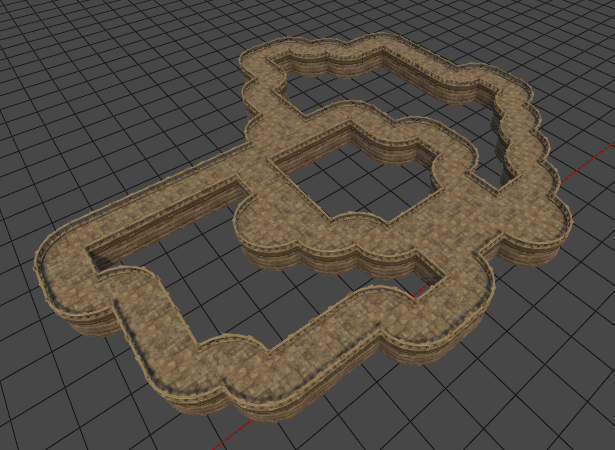
This is useful for quickly creating pathways.
Platform Rules
Let’s take a look at the first environment that was shown earlier, but this time from another angle:
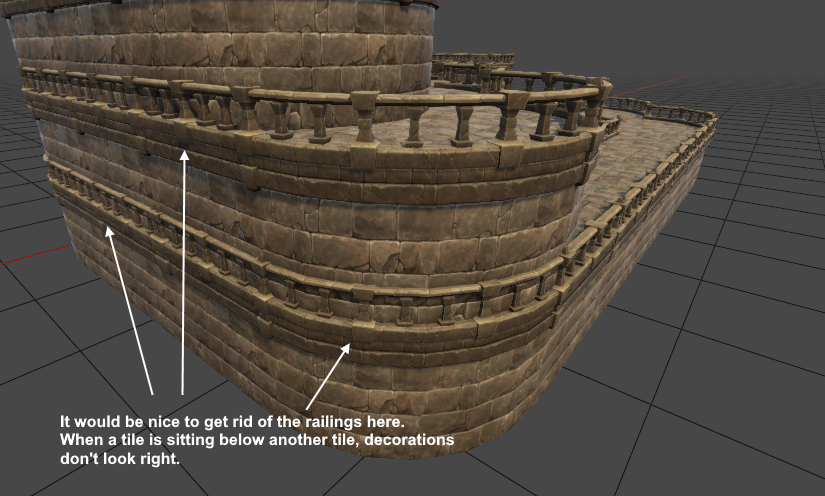
Notice that where the tiles stack on top of each other, the railings look a bit off. Although not entirely incorrect (it may be what you are looking after), it would be nice if we could somehow find a way to spawn only the floors (base) objects without decorations.
In order to do this, we can create a new tile rule and set its rule type to Platform:
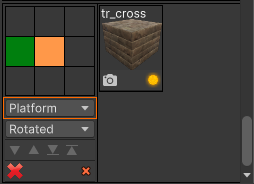
Note that we are using the same prefab as we are using for the Cross rule. This is just a simple floor object with no decorations.
Also, below the cell button grid, we set the rule type from Standard to Platform.
A single neighbor was set to green and it doesn’t matter which one we pick in this case. This will ensure that whenever a platform is detected this rule will be picked.
Let’s take another look at our tiles:

The railings have disappeared because the plugin can now use the platform rule instead. However, we are still not quite done yet. If we look at the bottom most platform tile (the one closest to the viewer), we can see that it sits below a rounded corner, but the platform tile has cubic shape. In order to fix this we will have to add a second platform rule that defines a turn:

Let’s have another look at our tiles:
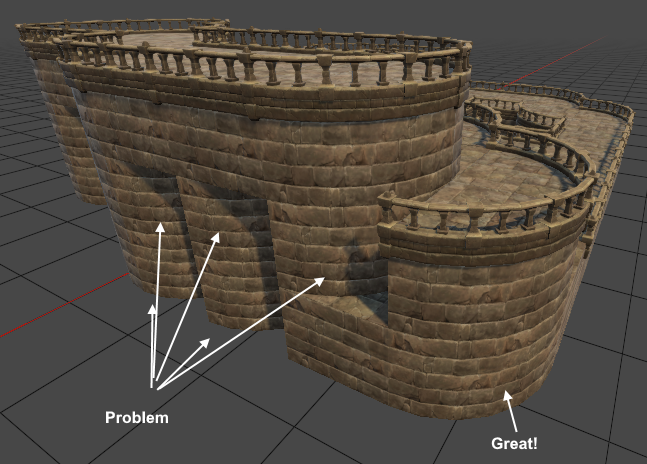
Our problem has been fixed, but now we have another one. Because we have added a new rule that uses 2 green tiles, some of the old platforms have been updated to correctly match this new rule. These tiles are actually TJunction rules. So let’s go ahead and add one final platform rule:
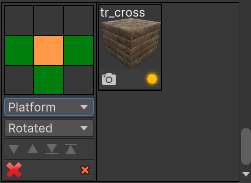
The result now looks like this which is exactly what we are after:
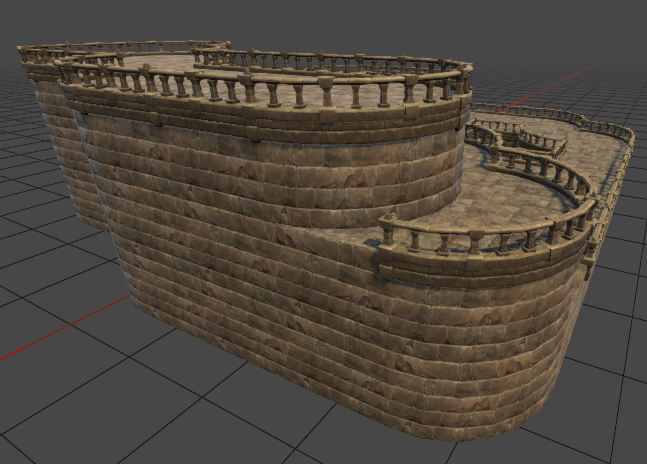
Ramp Rules
Another type of tile rule is the Ramp rule. You need to define at least one ramp rule in order to use the Ramp Paint tool.
The following ramp prefab was created for this example:
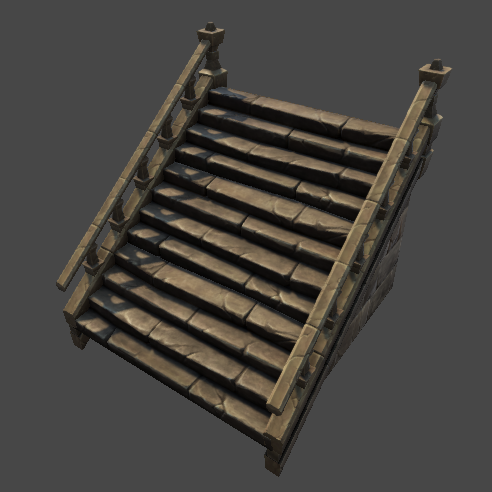
A ramp rule was created as shown below:

The ramp opens up along the negative X axis, so the left neighbor was made green.
At this point, you can activate the Ramp Paint tool and paint ramps.
The next image shows a new environment that uses ramp tiles:
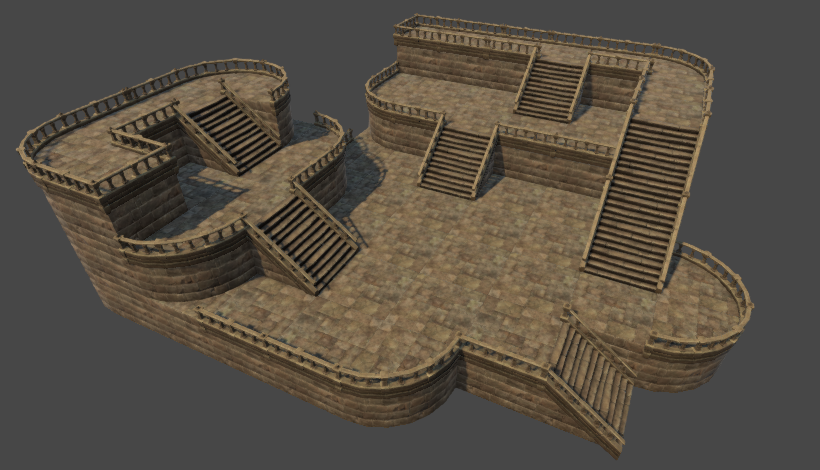
When placing ramps it is possible to run into situations where the ramp is surrounded by more than one tile and the ramp rotation may be incorrect. For example, consider the following scenario:
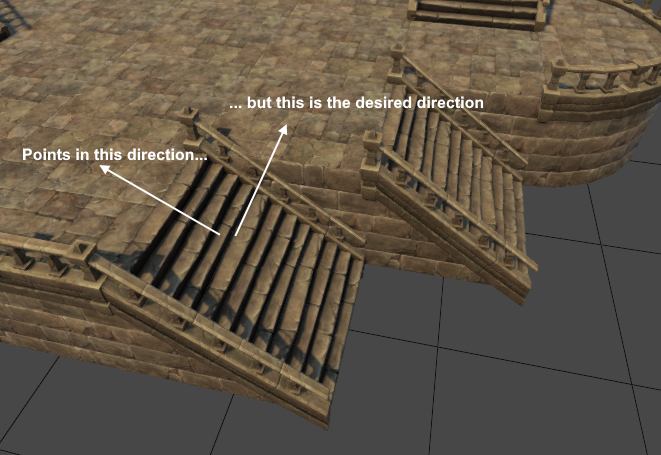
The ramp points to the left tile, but we want it to point towards the forward tile. You could probably define multiple ramp rules, but that can be tedious. Instead, you can place the ramp brush over the ramp and press [Y] to rotate it:
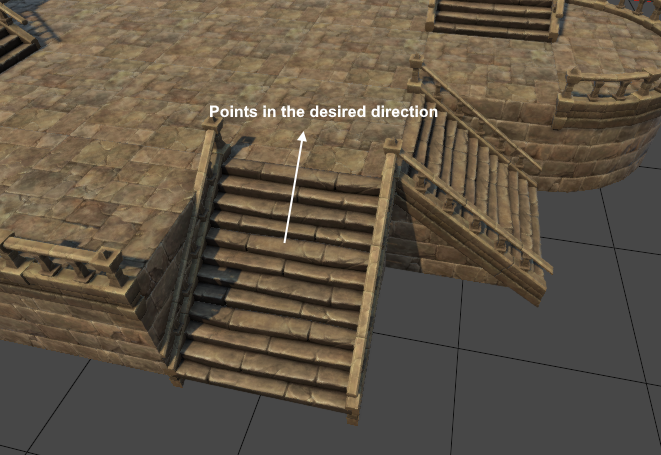
Note:When the tile grid gets refreshed, the ramp rotations will be restored properly as long as all ramp prefabs open up along the same axis in their model pose. For example, if the ramp rule contains multiple ramp prefabs, when the grid is refreshed, a ramp will be picked using the prefabs’ spawn chance property for each ramp tile in the grid. The picked ramp prefab might open up along a different axis compared to the old ramp tile and this can cause incorrect results to appear. The best way to avoid this is to make sure that all ramps open up along the same axis when creating the ramp prefabs.
The Connect Tool
The Connect tool can be very handy for creating suspended pathways.
In order to use, make sure you click on the Connect button in the Inspector to activate it:

Or press [R].
Next, follow these steps:
move the mouse to establish a start point;
left-click to start. This will create 2 perpendicular tile segments;
move the mouse to establish and end-point;
left-click to spawn;

You can hold down [CTRL + ALT] and use the scroll wheel to change the Y offset for the start and end points. You can do this before left-clicking to set the start point offset and post left-click to change the end point offset.
The Y offset is updated automatically when you hover a tile with the mouse cursor. In that case the start/end point will snap to the same cell in which the hovered tile resides.
Press [SPACE] to change the major axis. The major axis is the axis along which the first segment is travelling. In the image above, the first segment travels forward and the second segment travels to the right. Pressing [SPACE] would reverse these travel directions.
The next image shows an example where the start point sits on the grid and the end point has been raised above the grid:

Note that the ramps were added automatically in order to make the upper area accessible. Ramps will only be generated if a ramp rule is defined and if the Generate ramps toggle is checked inside the Inspector under the Connect UI section.
Also, towards the left, where the 2 segments meet in the corner, 2 tiles were inserted in order to make the ramp accessible.
The next image shows an example of a more complex path network:
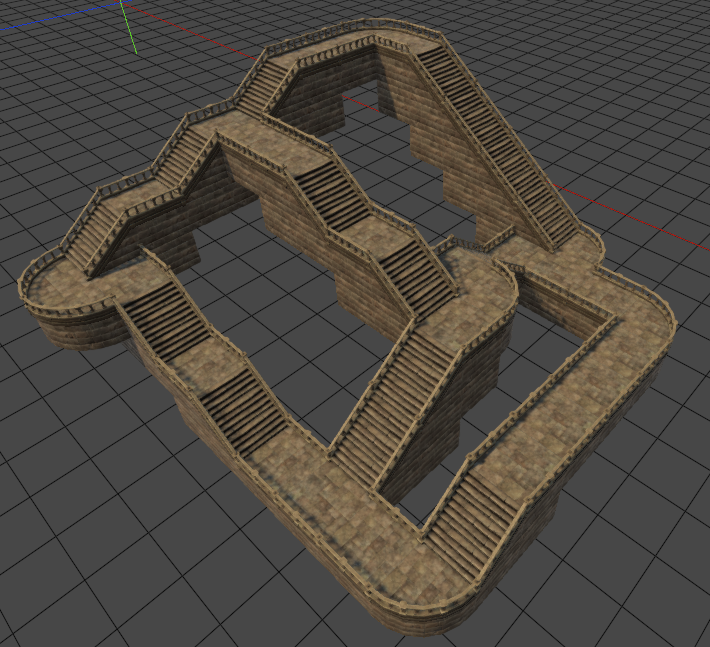
When using this tool, you need to sometimes be careful not to accidentally block existing pathways as shown below:
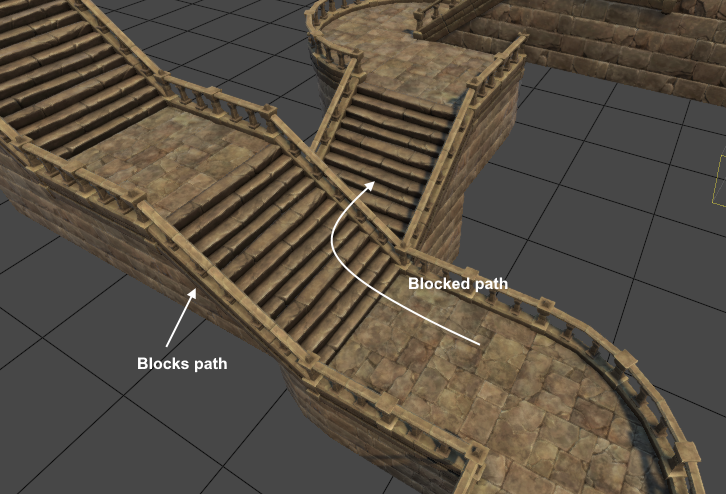
Tile Rule Priority
When painting tiles, the tile rules are evaluated in the order in which they appear in the tile rule window for each rule type. If you have 2 or more rules that use the same number of green tiles, the first one will be picked from bottom to top. This can produce incorrect results.
There are 2 ways to handle this:
be more specific by turning more of the adjacent cells green or red. The less neutral tiles, the more specific you are and the easier it will be for the plugin to understand your intentions;
use the move up/move down/move to top/ move to bottom buttons:

Pressing these buttons will move the rule up/down in the UI while also changing their priority.
Tile Rule Grid Refresh
When making changes to a tile rule profile (changing cell states, adding prefabs etc), all the grids which use that profile will automatically be updated.
As the number of tiles inside a grid grows, grid refreshing can become slow. In this case, you might want to turn off automatic updates, make the necessary changes to the tile rules, and update the grid manually:
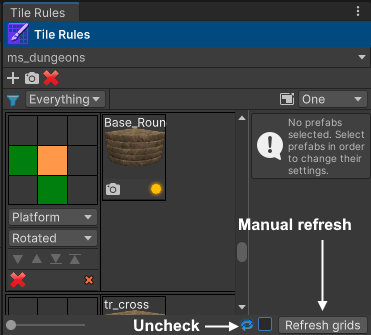
In the image above, the toggle at the bottom right has been unchecked. This means automatic refresh is turned off. The grid(s) can be manually refreshed by pressing the Refresh grids buttons.
Tile Rule Radius
By default, the tile rules use a radius of 1. This means that only the immediate neighbors are taken into account. In some situations you may want to use a larger radius. The largest radius you can have is 2.
In order to set the tile rule radius you need to follow the next steps:
set the radius to the desired value in the tile rule window UI:
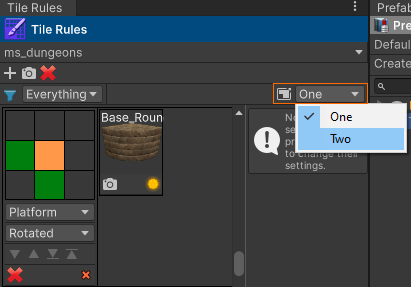
When you do that you’ll notice that the cell button grid will change appearance because there are now more neighbors that can be worked with:

This step will only enable you to use a radius of 2 inside the UI, but it doesn’t actually do anything besides that.
in the Inspector UI, you have to change the radius associated with the tile rule grid:
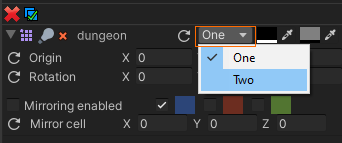
At this point, the new radius is taken into account when painting/erasing tiles.
Prefab Settings
When you click on prefabs in the tile rule profile window, the right pane will display a few settings:
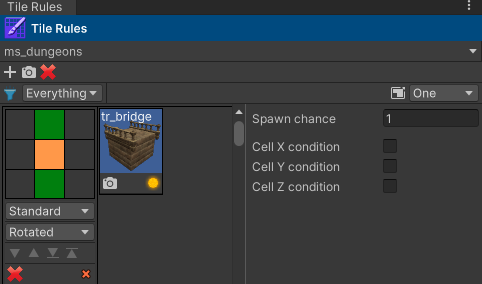
The spawn chance is useful when you have more than one prefab per rule. For example, you might have damaged versions of the same prefab that you would like to spawn. In that case, you can select the damaged versions and change their spawn chance to something like 0.2 or more depending on how often you would like those prefabs to appear in the scene.
The Cell X/Y/Z condition fields allow you to define a cell range where the prefab can appear in the tile grid. For example, let’s suppose you had 2 versions of a ramp rule prefab: one with railings on the side and another one with no railings. You may want to spawn the simple ram (no railings) when the Y coordinate is in the interval [0, 1] and the more majestic version (with rails) for all Y coordinates starting at 2 and upwards.
The next image shows the updated ramp rule:
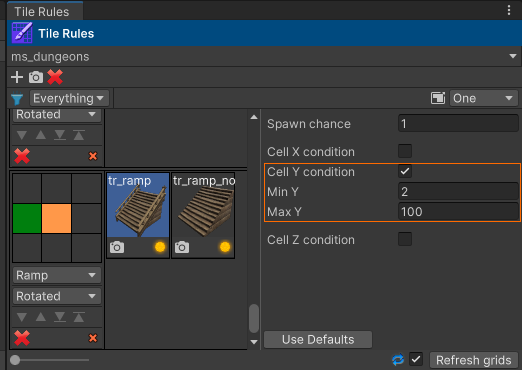
Note that there are now 2 ramp prefabs: one simple and one with railings on the sides. The one with railings on the sides has the Cell Y condition checked and the Y interval has been set to [2, 100]. A value of 100 in this case means “infinity” since it’s rare that you will have grids that go so high up.
The simple ramp uses an interval of [0, 1].
The next image shows a simple environment that was created using these updated ramp rules:
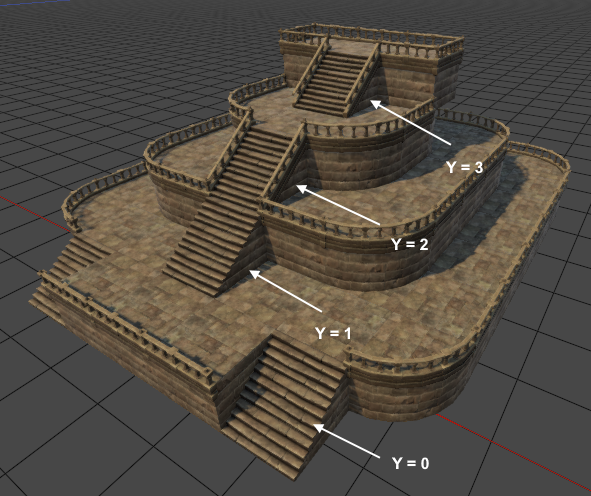
When any one of the Cell X/Y/Z condition toggles are checked, the prefab is said to be conditioned. When painting tiles, the plugin will first process the conditioned prefabs first and check if any one of these satisfies all conditions for the current cell that is being painted. The first prefab that satisfies all conditions will be picked. If all prefabs are conditioned, but no prefab satisfies the conditions, the spawn chance will be used to randomly pick a prefab.
Fixing Overlaps
The tiles that we have been using have these pillars attached to them and the pillars sit right where the tiles connect with adjacent tiles which also have pillars. This causes a problem to appear where the pillars from 2 or more connecting tiles overlap with each other. The next image shows an example of this:
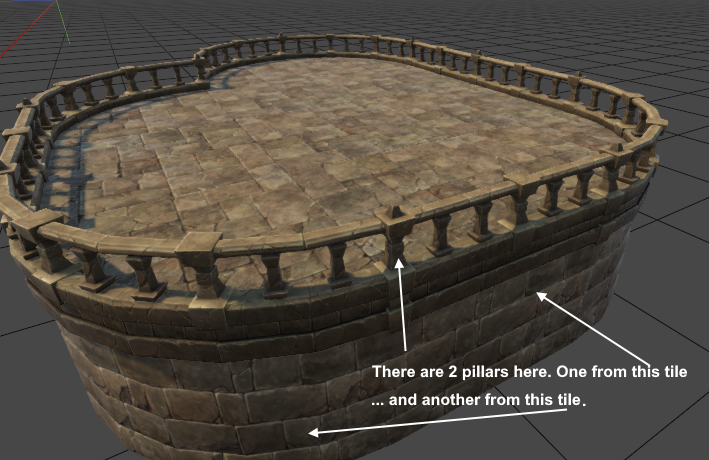
This can cause rendering artifacts. Although we can’t see the artifacts in the image, when moving the camera, there is flickering effect because the 2 pillars are fighting with each other over which one gets rendered.
In order to solve this, you have to go to the tile rule grid list in the Inspector and click on the Fix overlaps button as shown below:
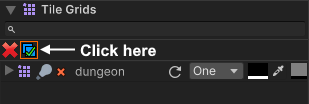
This will hide the renderers of the overlapping pillars so that a single pillar gets rendered.
As you can see, this is a manual step. When you paint/erase tiles, the same issue can appear again because new tiles are created so it is best to perform this step at the end, when your game level is finished.
Props Spawn

The Props Spawn tool is great for populating your scenes with props. For example, you could use it to populate your terrains with trees, houses, fences, barrels and the like. You can also spawn directly on other mesh surfaces. If you are creating a modular environment, you could use this tool to spawn props on the floor or on the walls.
In order to use, double-click on a prefab in the Prefab Manager window. This will activate the spawn guide and you can move it around in the scene. Instead of snapping to the grid (as is the case with the previous tools that were discussed), it will snap directly to mesh or terrain surfaces.
The following hotkeys are available when working with Props Spawn:
[SHIFT + mouse move] - rotate the spawn guide around the surface normal if axis alignment is turned on; rotate around the grid Y axis if axis alignment is turned off;
[CTRL + mouse move] - scale the spawn guide;
[ALT + mouse move] - offset the spawn guide from the surface (useful for embedding on steep surfaces);
[R] - reset the offset applied by moving the mouse back to 0;
The [X/Y/Z] & [SHIFT + X/Y/Z] hotkeys are also available for rotating the spawn guide using the keyboard. You can press [I] to reset the object rotation to the rotation stored in the prefab asset and [O] will reset the scale to the prefab scale.
Axis Alignment
Axis alignment refers to the idea of aligning one of the spawn guide’s axes to the surface on which it resides. By default, it is turned off, but you can turn it on/off by either pressing [SHIFT + A] or by checking/unchecking the Align axis toggle in the Inspector:
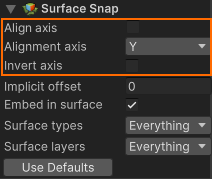
If Align axis is checked, you also need to specify an alignment axis using the Alignment axis field. The alignment axis is considered to be the positive axis. If you wish to use the corresponding negative axis, check Invert axis.
Typically, you will want to leave this off. For example, if you want to populate terrains with trees, axis alignment should be turned off. Trees grow upwards and they don’t look right when aligned with the terrain surface. Houses also usually stand straight up.
Axis alignment could be useful if for example you were placing objects on an incline or a ramp or some kind of decorative elements such as elongated crystals on top of rock surfaces.
Surface Offset & Embed in Surface
Although you can change the offset from the surface using the mouse, you can also use an implicit offset by changing the value of the Implicit offset field. This can be useful when placing objects on steep surfaces with axis alignment turned off in order to avoid floating.
The field Embed in surface can sometimes help, but for objects that are more irregular at the base where they meet with the surface, it won’t always avoid floating. In this case a combination of implicit offset and mouse applied offset should do the trick.
The next image shows an example of a barrel placed on a steep terrain surface with and without Embed in surface:
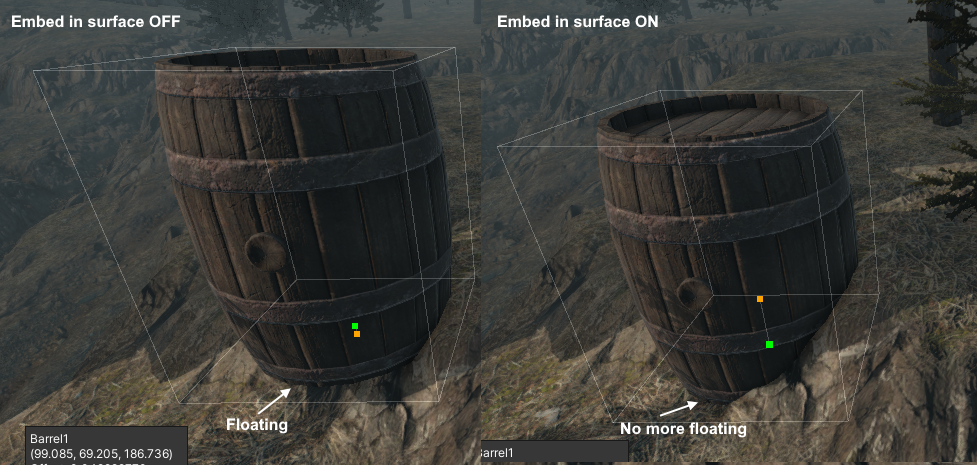
Surface Types & Surface Layers
By default, every object in the scene can be used as a surface on which the spawn guide can sit. However, there may be times where you would like to ignore certain objects. For example, if you are placing props in a dense forest, you will most likely want to ignore the trees and snap to the terrain only.
The Surface types field allows you to select the types of surface the spawn guide can sit on:
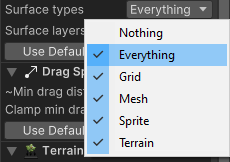
Another thing that you can do is to ignore certain surfaces based on the layer to which they are assigned. In this case, the Surface layers field can be used.
Spawn Guide Randomization
A useful feature when working with Props Spawn is Spawn Guide Randomization. This feature allows you to randomize the spawn guide’s rotation, scale and prefab. The randomization parameters are applied after you spawn a new game object:
left-click to spawn;
object gets spawn with current rotation/scale/prefab;
spawn guide is randomized;
Randomization also works with drag spawn.
Note:This feature is also available when using Modular Snap Spawn although it is not as useful. Usually, the objects that you spawn with Modular Snap Spawn should keep their original size and rotation. For example, you definitely wouldn’t want to randomize the scale of a wall piece or a floor. These were designed in a specific manner by the artist to allow for the easy construction of modular environments.
Rotation Randomization
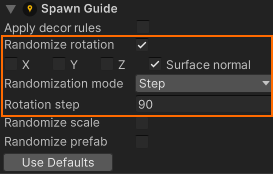
In order to randomize the rotation, check the Randomize rotation toggle and then pick the randomization axis. The default is Surface normal which is what you will usually want for props placement.
The Randomization mode field can be set to Step or MinMax. Step will apply a random multiple of the specified rotation step, whereas MinMax will generate a random rotation value in a specified interval.
Scale randomization
Check the Randomize scale toggle. This will cause 2 new fields to show up which will allow you to define a minimum and maximum scale value. Very useful for adding more variation to certain types of objects.
Prefab Randomization
Prefab randomization refers to the fact that after you spawn a new object, the spawn guide will pick a new prefab for the next spawn. Simply check the Randomize prefab toggle and then select the random prefab profile that contains all the prefabs that you wish to use.
Drag Spawn
When working with the Props Spawn tool, you can hold down the left mouse button and drag to spawn.

While dragging, a new object will be spawned when the mouse cursor travels a world distance >= Min drag distance. This allows you to adjust the distance between objects that get spawned during drag.
It is recommended to keep the Use safe drag distance field checked in order to avoid any overlaps between the spawn guide and the previously spawned object. Note:When this field is checked, the radius of the sphere that encloses the object volume will be used as a minimum drag distance.
The next image shows a few barrels that were spawned using spawn guide scale & prefab randomization and drag spawn:
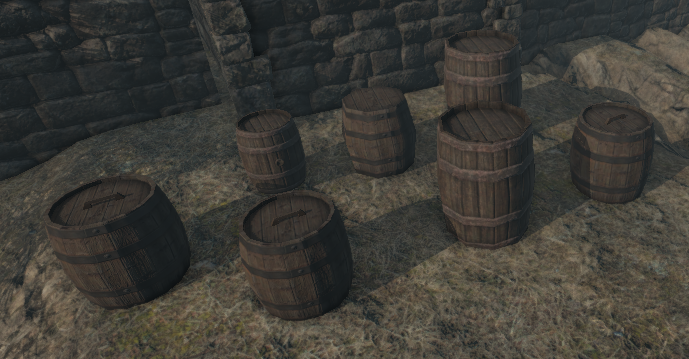
Terrain Flattening
Props Spawn supports a feature called Terrain Flattening. When enabled, it allows you to flatten the terrain area surrounding the spawn guide when you spawn objects either during left-click or drag spawn.
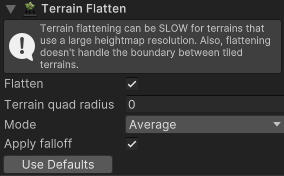
Make sure you have the Flatten field checked in the Terrain Flatten UI section to enable flattening.
Use the Terrain quad radius field to establish the flatten radius or hold down [CTRL] and use the mouse scroll wheel.
The Mode field allows you to specify how the new terrain height is calculated. Possible values are:
Lowest - the height of the terrain will be set to the lowest height value inside the flatten radius;
Average - the height of the terrain will be set to the average height value inside the flatten radius;
Highest - the height of the terrain will be set to the highest height value inside the flatten radius;
Checking Apply falloff can sometimes help smooth out hard transitions.
Note:As you might have seen in the image above, terrain flattening comes with some limitations. First, it is extremely slow for heightmap resolutions of 1025 x 1025 and above (this of course also depends on the system on which the Unity Editor is running). One way to get around this is to change the terrain’s heightmap resolution to a lower value if it doesn’t degrade the quality of the terrain too much. In order to change the heightmap resolution, follow the next steps:
select the terrain object in the hierarchy view;
in the Inspector, click on the Terrain Settings button:

scroll down to Texture Resolutions (On Terrain Data) and change the heightmap resolution:
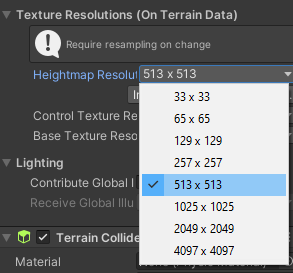
Secondly, it doesn’t support tiled terrains. When tiled terrains are used, you will see the flatten radius being clipped to the tile the spawn guide is sitting on.
Scatter Brush Spawn

The Scatter Brush Spawn tool allows you to paint objects using a circular brush. This can be very handy for painting forests for example. You can use it to paint objects on terrains, but you can also paint on top of planar meshes (e.g. floors, walls);
In order to paint objects, you first need to create a Scatter Brush Prefab Profile which holds all the prefabs that will be used for painting.
Then, you need to select the profile you created inside the Inspector (the Default profile will be used in this discussion):
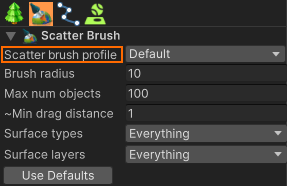
Finally, hold down the left mouse button and drag to paint objects.
You can use [CTRL + scroll wheel] to change the brush radius, or simply set it inside the Inspector using the Brush radius field.
Creating a Scatter Brush Prefab Profile
Open Tools > GSpawn > Windows > Scatter Brush Prefabs…
The following window will appear on the screen:

You can use the Default profile or click on the drop-down and create a new profile. The Default profile will be used in this discussion.
Next, you need to drag prefabs from the Prefab Manager window and drop them into the left pane inside the Scatter Brush Prefabs window. The following image shows the same window after it has been populated with prefabs:
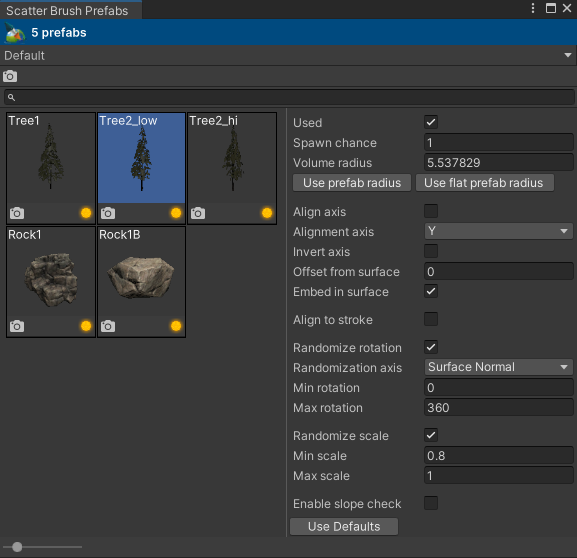
The Used property can be useful for temporarily disabling prefabs. A disabled prefab will not be spawned while painting. The Spawn chance defines how frequently a prefab will be picked. Valid values are in the [0, 1] interval.
Volume Radius
The volume radius represents an approximation of the original (i.e. no scale applied) prefab size. By default, when a prefab is added to the scatter brush profile, its volume radius will be set to the flat volume radius. This radius represents the radius of a cylinder that surrounds the prefab around the Y axis.
The Volume radius field can be used to set a custom radius. There are also 2 buttons which can be used to change the volume radius:
Use prefab radius - sets the volume radius to the radius of a sphere which encloses the prefab. This is rarely useful (unless you are working with sphere prefabs) as it can lead to really large values especially for tall objects such as trees;
Use flat prefab radius - sets the volume radius to the radius of a cylinder the surrounds the prefab around the Y axis;
The next image shows a few trees painted using the default volume radius (i.e. flat prefab radius):
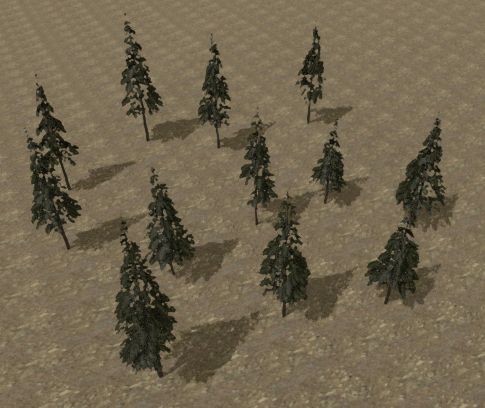
As you can see, the trees are quite far apart. This is because of the volume radius. If we decrease the volume radius, we can get more density. The following image shows some trees which were painted with a volume radius of 2:
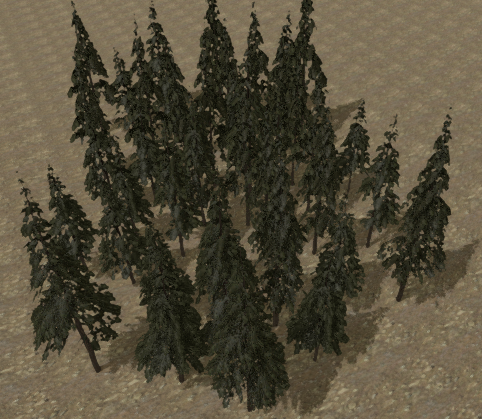
Note:When the scatter brush prefab profile uses too many prefabs and the prefabs use fairly large volumes, you will need to increase the brush radius. Otherwise, most prefabs won’t have a chance to be picked. This happens for 2 reasons:
too many prefabs means less chance to be picked;
a large volume radius occupies more space so even if these prefabs will eventually be picked, there will be no more room left for them.
The volume radius can also be used as a simple repel mechanism. The following image shows an example of this:
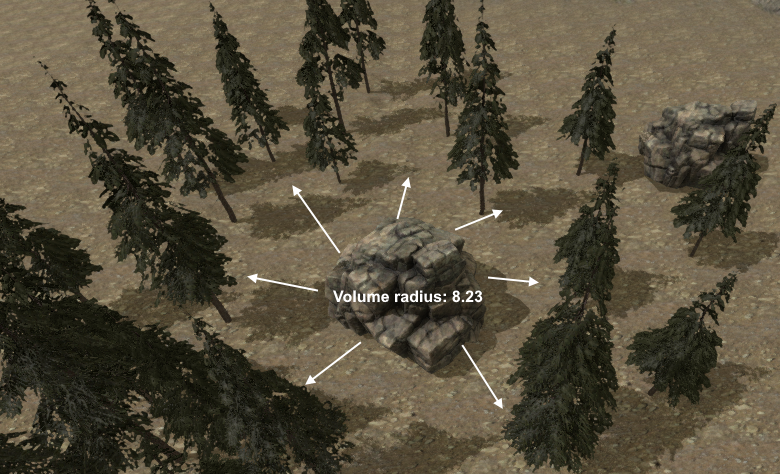
The rock in the middle of the trees uses a volume radius of 8.23. Note how there is quite a bit of space between the rock object and the surrounding trees.
The next image shows a similar situation, but this time the radius of the rock prefab has been set to 2:
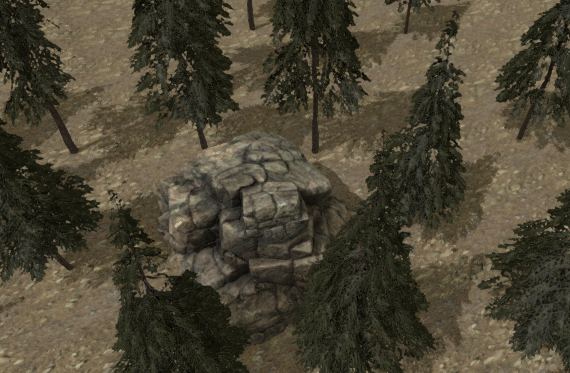
This time the trees are much closer to the rock.
Embed in Surface & Offset from Surface
The Embed in surface field will attempt to project the objects onto the surface on which they reside in order to avoid floating. This usually works best with objects that have a somewhat flat area where they connect to the surface. For more irregular objects, such as rocks for example, you might want to also set a small negative value in the Offset from surface field to push them down a bit.
Slopes
Each prefab has a field called Enable slope check. When checked, it will allow you to enter 2 values which represent a minimum and a maximum slope:

This allows you to prevent objects from being spawned on steep inclines. For example, the minimum and maximum slope values of 0 and 45 respectively mean that the prefab will only be spawned on surfaces whose angle with the horizontal XZ plane is <= 45 degrees.
If we were to use a minimum slope value of 60 and a maximum slope of 90, the objects will only spawn on very steep surfaces. Flat surfaces will be ignored in this case.
In general, if you want a prefab to spawn on relatively flat surfaces a pair of values such as [0, 15] will do.
Curve Spawn

The Curve Spawn tool is very handy for spawning fences, forests, house rows and the like.
Before you can use this tool you need to create one or more Curve Prefab Profiles.
Curve Prefab Profiles
A curve prefab profile holds a collection of prefabs that can be spawned along a curve. For example, if you wanted to create fences, you can create a profile that holds different fence prefabs. These can be regular or damaged fence parts for example.
In order to create a profile open Tools > GSpawn > Windows > Curve Prefabs…
The following window will appear on the screen:
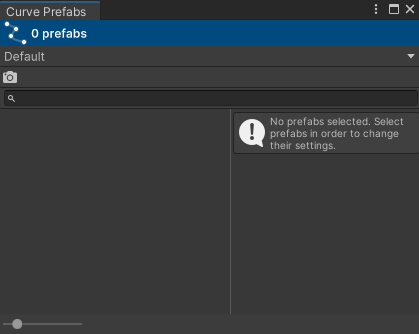
Click on the drop-down control, select Create new profile… to create a new profile. The next image shows the same window after a new profile has been created to hold fence prefabs:
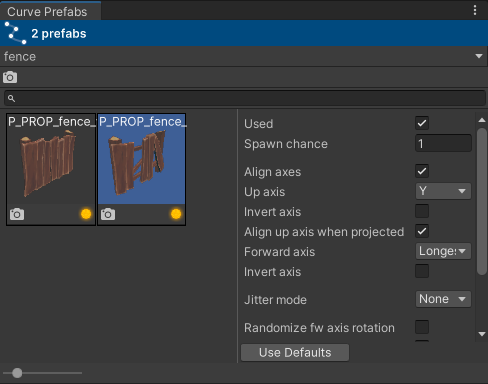
2 fence prefabs have been added that can be used to spawn fences. In order to add prefabs, you need to drag them from the Prefab Manager window and drop them inside the left pane in the Curve Prefab Profile window.
Curve Creation Settings
In the Inspector you can see a bunch of settings under the Curve Creation UI section:
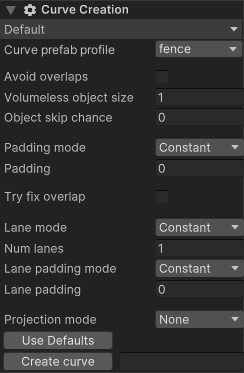
Each curve that you create has its own settings associated with it, but the settings you see above are the initial settings that are used for newly created curves. Once a curve is created, you can change its settings.
The most important field is the Curve prefab profile field which allows you to pick the prefab profile you would like to use with the new curve you are about to create. You can also change the profile after the curve is created if you wish. In this example, the fence profile that we created earlier was used.
An important thing to note is that these settings can be organized in profiles. This is not mandatory, but it can be useful if you are creating different categories of curves because it allows you to avoid having to change the settings all the time. If you organize your settings in profiles, you can simply select the profile and the settings will update automatically.
Creating a Curve
In order to create a curve, give the curve a name and click on the Create curve button. This will create a new curve and add it to the Curves list in the Inspector:
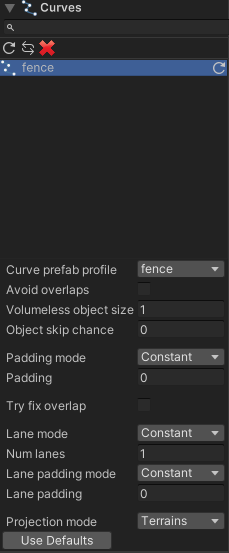
You can have as many curves as you wish and you can select them in this list and make changes to them. Note the settings that exist below the curves list. These can be used to change the settings for each created curve.
Moving the mouse over the scene view, you will see a small tick. This represents the first control point of the curve. In order to actually build the curve, follow the next steps:
left-click to add a new control point;
keep adding control points and move the mouse to establish their position;
when done, hold down [SHIFT] and left-click to commit;
The next image shows a simple fence that was constructed using the fence profile:

Manipulating Control Points
You can select control points by clicking on them. You can hold down [CTRL] and left-click to append. You can press [CTRL + A] to select all control points inside a curve.
You can insert a new control point by pressing [C]. This will allow you to move the mouse cursor next to the curve and left-click to insert a new control point.
There are 3 gizmos available:
move gizmo [W] - move selected control points;
rotation gizmo [E] - rotate the entire curve around its center point;
scale gizmo [R] - scale the curve from its center point;
You can also change the current gizmo from the gizmo toolbar:

You can press [SHIFT + F] to project the curve on the object that resides under the mouse cursor or the grid.
Duplicating Curves
You can press [CTRL + D] to duplicate the curves that are selected inside the curves list. Note:The scene view has to have focus for this to work. So make sure you click (any mouse button will do) in the scene view first before duplicating. This can be useful in some situations because it helps you avoid having to build a curve from scratch:

Terrain Projection
When placing curves on top of terrains that have many hills or bumps, moving the control points around might cause certain objects to become embedded inside the terrain or float above it. You can fix this by projecting control points using the [SHIFT + F] hotkey discussed earlier, but sometimes there is simply not enough control point granularity and adding more may not be feasible and/or may not fix the problem.
The best way to handle this is to enable terrain projection for all objects that reside inside a curve. Control points won’t be affected, but the objects will always sit on top of the terrain.

This will ensure that the spawned objects will be projected on top of the terrain that is sitting below them no matter where the control points are positioned.

The image on the left shows how a curve might look like without projection enabled. The image on the right shows the result after the projection feature has been enabled.
By default, when the objects are projected on the terrain, their up axis will be aligned to the terrain surface normal. If you wish to change this, go to the Curve Prefab Profile window, select the prefabs and uncheck the Align up axis when projected field:
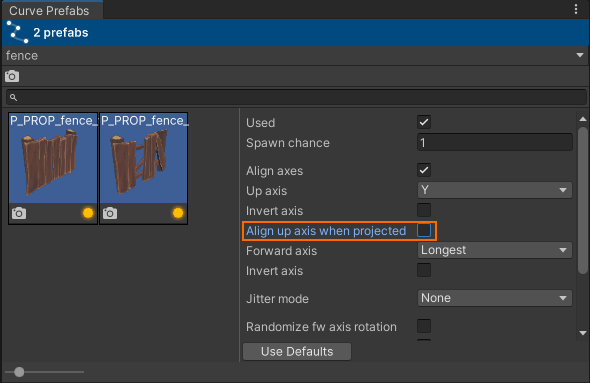
Multiple Lanes & Overlaps
You can spawn objects along multiple lanes that run parallel to the same curve. The following image shows a new curve that uses a different prefab profile and has had its lane count set to 3:

The curve settings have been changed as shown below:

If you wish to build forests using the curve spawn tool, you should set the Lane mode field to random:

This will randomize the number of lanes for each slice giving you a less uniform result. Randomizing the scale of the curve prefabs and enabling jittering can also help:
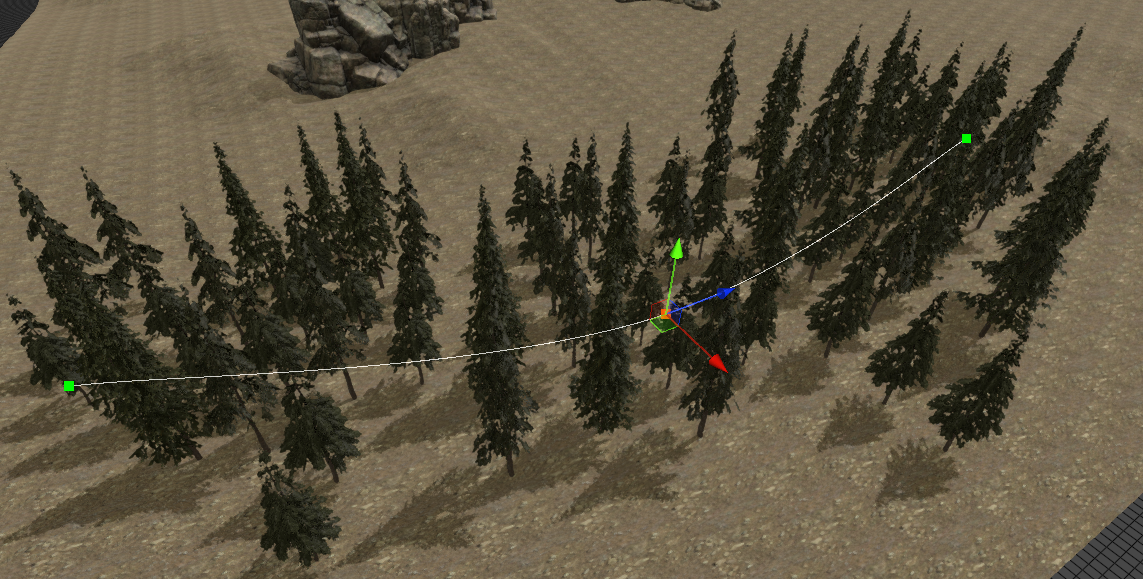
The next image shows a snapshot of the prefab settings:
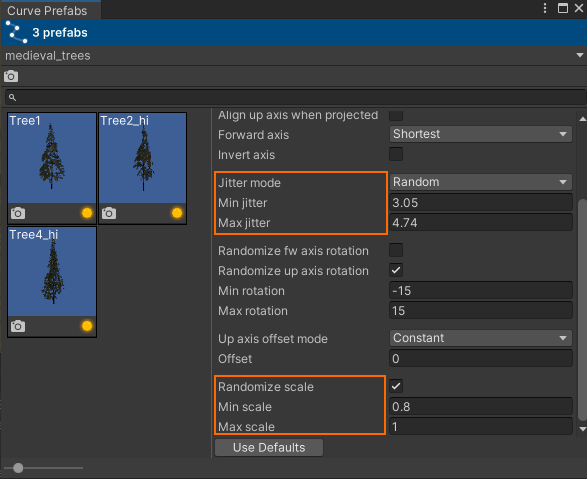
Note: When using more than 1 lane, it is possible for objects to overlap in places where the curve takes a steep curve. You might need to adjust the position of control points to reduce overlap.
Note:When any kind of randomization is used, the objects will swirl around when you move the control points. This is because moving the control points causes the entire curve to be refreshed and randomization causes different values to be used each time.
Overlap can also happen even when using a single lane:
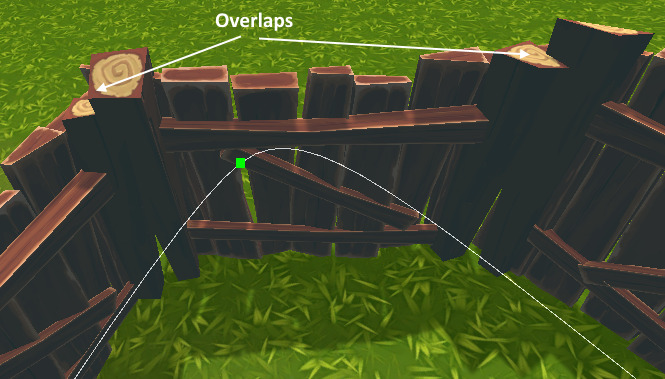
For the one lane case, you can check the Try fix overlap toggle in the curve settings to eliminate the overlap:

The next image shows the same curve but with this toggle checked:
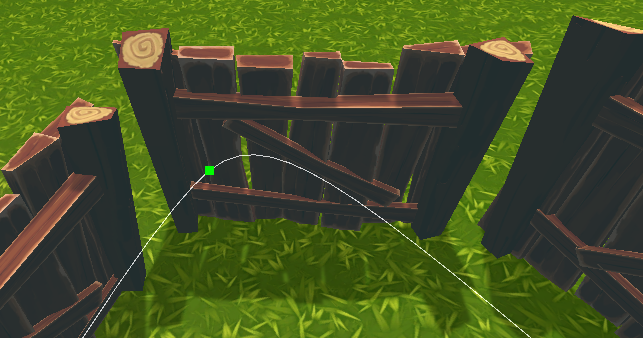
Note:As the name suggests, the Try fix overlap functionality will attempt to fix the overlap but there are edge cases where this won’t work. Also, sometimes you might see objects being pushed aside (i.e. away from the curve). When this happens you will need to move some of the control points around the area where this happens.
Prefab Forward & Up Axes
Each prefab used inside a curve has 2 axes associated with it:
forward axis - points in the direction the curve is moving/extending;
up axis - runs perpendicular to the curve;
These can be set from the Curve Prefab Profile window:
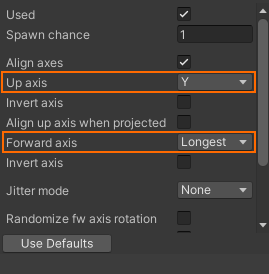
A visual representation of these axes can be seen below:
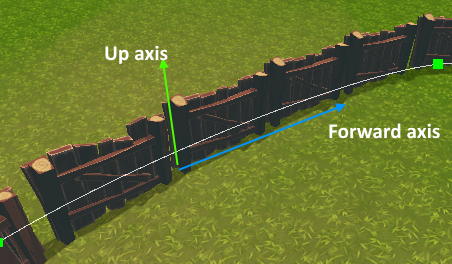
Possible values are:
X- the prefab local X axis;
Y - the prefab local Y axis;
Z - the prefab local Z axis;
Longest - the lonest prefab local axis;
Shortest - the shortest prefab local axis;
Note:You might see strange/incorrect results if the forward and up axes are mapped to the same prefab local axis. For example, you might set the forward axis to Longest and the up axis to Y. But if the longest axis is Y, then the 2 are actually the same. As a rule of thumb, if objects look weird along the curve, this should be the first thing to look into.
Physics Spawn

Physics Spawn allows you to spawn objects using physics simulation.
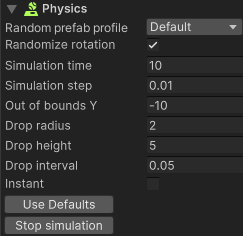
The first thing you need to do is to setup one or more random prefab profiles. Then, you have to set the Random prefab profile field to the profile you created. When spawning objects, the tool will randomly pick a prefab inside this profile and drop it in the scene with physics simulation.
To spawn:
left-click
OR
hold down the left mouse button and drag;
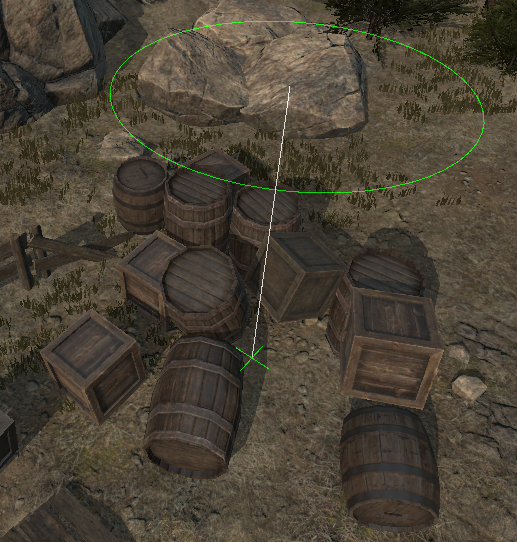
The image above shows how the Physics Spawn tool was used to spawn barrels and crates.
The green circle represents the drop area. Prefabs are randomly picked from the random prefab pool and a random position is generated inside this circle. You can hold down [CTRL] and use the scroll wheel to change the radius.
The white line represents the drop height. Hold down [SHIFT] and use the scroll wheel to change the height.
Drop interval specifies the drop frequency. For example, a value of 0.1 means that when dragging the mouse, objects will be dropped every 0.1 seconds.
The Instant toggle allows you to specify if the simulation should play out instantly. By default, this is unchecked, which means that you will actually get to see how objects fall to the ground and collide with the environment.
You should keep the Simulation step field to a value smaller than 0.03 as suggested in the Unity Docs.
The Out of bounds Y field allows you specify the Y position where physics objects are considered to be out of bounds. When an object reaches this position, it will automatically be destroyed. This is useful because some objects might spawn in places where there might not be any ground below them or they might roll off a surface such as a terrain and begin to fall down ‘forever’.
Undo/Redo
When the Instant field is unchecked, you should wait until the simulation has finished before you Undo & Redo. Otherwise, if you Undo and then Redo, the object positions will be incorrect. If you have to Undo & Redo frequently, it is best to check the Instant toggle.
Decor Rules
When decorating environments with the Props Spawn tool, it may sometimes be difficult to spawn objects in the exact desired position. The next image shows an example where a lid sits next to a sarcophagus object, but its stance can not be reproduced using the vanilla Props Spawn tool:
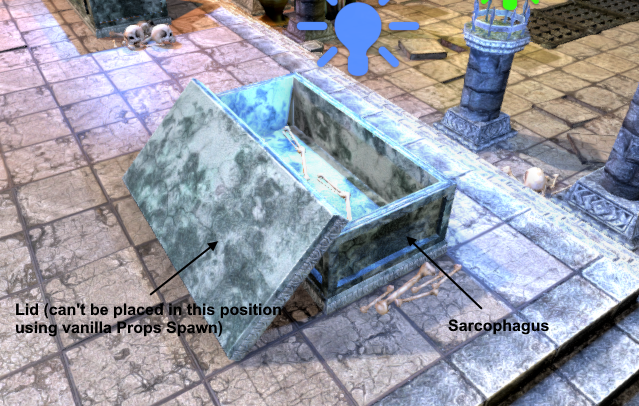
Even if you tried placing the lid on top of the sarcophagus it would still be difficult. This is where the Decor Rules feature comes to the rescue. This is a feature that needs an example scene as input. Luckily, virtually all asset packs that you can purchase from the store are delivered with high quality demo scenes created by the artists. Once this scene is loaded, the plugin can parse the scene and detect the way in which objects decorate each other. Then, you can use this information to decorate your objects in your own scenes.
Creating Decor Rules
Drag and drop the prefab asset folders inside the Prefab Library window to populate it with libraries and prefabs and then switch to one of the demo scenes that comes with the asset pack you wish to use. In this example, an asset pack called Village Interiors Kit by 3DForge was used and the demo scene that was loaded is called The Crypt - TopDown.
Make sure to also initialize GSpawn in this scene before you can use it.
Next, open up the Prefab Library window and click on the Generate decor rules button in the top toolbar as shown in the image below:
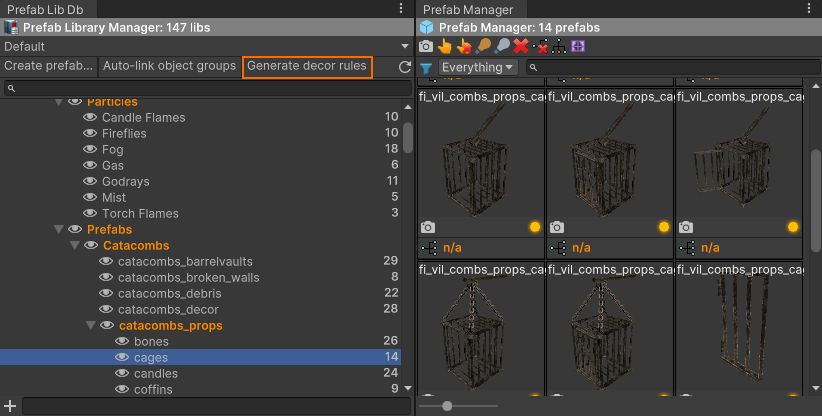
A progress bar will appear and once the process is finished, you are ready to use the generated decoration rules.
Using Decor Rules
In order to use the generated rules, you need to activate the Props Spawn tool and inside the Inspector, under the Spawn Guide section, you need to check the Apply decor rules button as shown below:
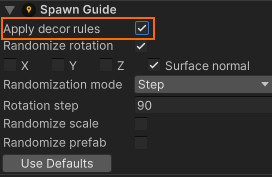
From now on, when you move the spawn guide with the mouse, the plugin will check if the object under the mouse cursor is decorated by the spawn guide’s prefab. If it is, the spawn guide will automatically change its position and rotation based on the decor rules that was detected.
You can toggle the decor rules by pressing [SHIFT + V] instead of using the Inspector UI.
Note:Because decor rules override the spawn guide position and rotation, you can no longer change the rotation with the mouse. However, you can still change the spawn guide rotation using the X/Y/Z keys.
Note:When you want to left click to spawn, make sure the [ALT] key isn’t pressed. Otherwise, it will replace spawn guide prefab.
Because a prefab can decorate an object in more than one way, there may be more than one decor rule available. You can change the current rule by holding down [ALT] and using the mouse scroll wheel. When you do this, you will see the spawn guide changing its position and rotation based on the new rule that was activated.
The image below shows how the lid can be placed near the sarcophagus:
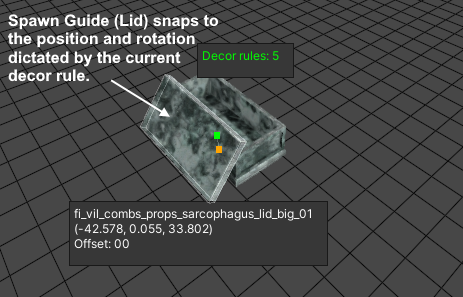
The spawn guide uses one of the lid prefabs and the mouse cursor was placed over the sarcophagus. The plugin has detected that the lid decorates the sarcophagus in 5 different ways (notice the green label that shows the number of available rules) and picked one of the rules to snap the position and rotation of the lid.
Here are the other rules that apply in this case:

By holding down [ALT] and using the mouse scroll wheel, different decor rules were traversed. This allows you to quickly decorate objects in different ways with automatic position and rotation snapping.
Here is another example of when decor rules can be usefu:
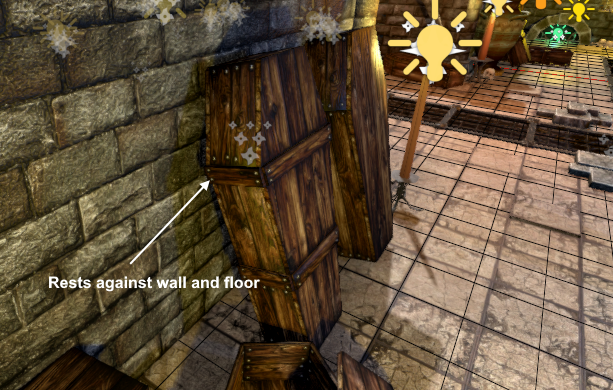
In the image above, the example scene shows 2 coffins that are resting against a wall and the floor. Again, using vanilla Props Spawn will be a bit difficult to place these coffins in this position, but when using decor rules, the coffins will automatically snap into place:

We can also palce a skeleton using the same approach:

Adding New Rules
Let’s assume that some of the prefabs that you would like to use don’t contain enough rules. In this case, you can follow these steps:
create a copy of the demo scene that you would like to use;
inside the demo scene copy, create the decor rules that you would like using a combination of Props Spawn and move & rotate gizmos. For example, you might want to add more rules for the sarcophagus lid. For each rule you would like to create, place a new sarcophagus and place the lid in the desired position and rotation.
In the Prefab Manager, select the prefabs (lid prefabs in this example) and click on the button highlighted in the image below:
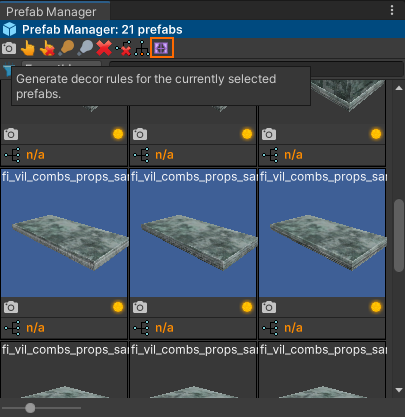
Note:Whenever you generate decor rules for prefabs, the old ones are going to be erased and replaced by the rules detected in the currently active scene. This is why it is important to use a single example scene where all possible rules exist.
Limitations
The Decor Rules feature really depends on the example input provided. If a prefab doesn’t decorate objects in the example scene, it won’t be able to take advantage of decor rules. The plugin tries to use name matching to borrow rules between prefabs and this can help a lot sometimes. For example, if the artists has created 3 versions of the same object: sarcophagus_01, sarcophagus_02, sarcophagus_03, but only sarcophagus_01 exists in the example scene, the plugin will copy the rules from sarcophagus_01 to the other 2 versions.
Some rules may snap the spawn guide such that it floats above the ground. This can happen when prefabs decorate more than one object at a time in the same area.
Mirroring
Mirroring is a very handy feature which allows you to work on areas of your levels that contain symmetry. This feature works by giving you control over a gizmo that defines the mirror planes against which objects can be mirrored.
Mirroring is available in selection mode and also in spawn mode for the following spawn tools:
Modular Snap;
Segments;
Box;
Props;
Tile Rules;
The Mirror Gizmo
The next image shows how a mirror gizmo looks like:
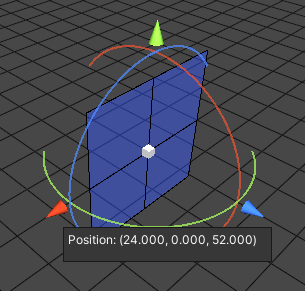
The cone handles allow you to move the gizmo around in the scene. Hold down [CTRL] to enable snapping.
The circles allow you to rotate the gizmo. Again, [CTRL] enables snapping. By default the rotation handles are hidden. You need to check the Rotation handles field in the mirror gizmo settings to make them visible.
The white cube handle in the middle allows you to drag the mirror around in the scene by snapping it to the grid or to object bounding volumes. When the mouse hovers an object, the mirror will snap to the intersection point between the mouse cursor and the object and then it will snap it to the scene grid.
To toggle the gizmo, press [CTRL + Q].
To snap the mirror into view, press [CTRL + F].
Multiple Mirror Planes
In the previous example, only a single mirror plane is enabled, but a maximum of 3 planes can be used at the same time to mirror along different axes at once. The next image shows the same gizmo with 2 and 3 planes enabled:
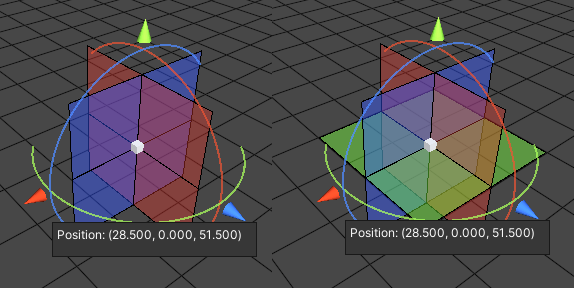
Mirror Gizmo Settings
The next image shows the mirror gizmo settings which can be changed from the UI:
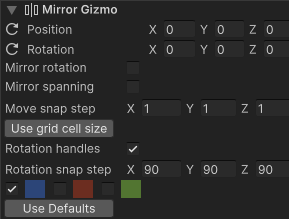
The Position and Rotation fields allow you to modify the position and rotation values form the UI. Although the handles can be used for the same purpose, the UI allows you to be precise.
The Mirror rotation toggle should be checked if object rotations should also be mirrored. If unchecked, only the object positions will be mirrored.
Mirror spanning allows you to specify if objects that are spanning one of the mirror planes should be mirrored or ignored.
Move snap step allows you to control the amount of movement applied when moving the gizmo with the handles while snapping is enabled.
Pressing the Use grid cell size button will set the move snap step to the grid cell size. You will have to press this button again if you change the grid cell size later.
The Rotation handles toggle allows you to toggle the visibility of the rotation handles. For example, if you don’t wish to apply any rotations to the gizmo (at least not using the circle handles), then you can uncheck this toggle.
Rotation snap step defines the rotation step used when rotating with the circle handles while snapping is enabled.
Finally, the 3 colored squares allow you to toggle the visibility of the mirror planes. They are color coded so you can easily match them.
Note:The gizmo settings are not shared between different contexts. For example, the mirror settings used in Selection Mode are not shared with the mirror setting used in Modular Snap, Segments, Box etc. Each tool that supports mirroring has their own mirror settings.
Rotation Mirroring
In the previous section the mirror gizmo settings were discussed and the Mirror rotation field was mentioned. This section will discuss this field in a bit more detail.
Not all objects require this field to be checked. For example, the image below shows a few examples of objects that don’t require rotation mirroring:

The next image shows an example of a few object that do require rotation mirroring to be enabled:
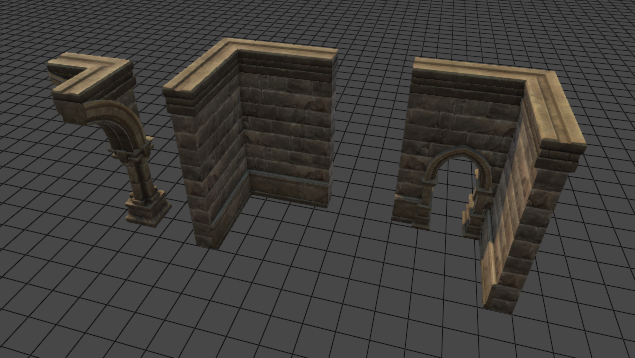
Let’s the inner corner object from the image above and mirror it without rotation mirroring enabled and see what this looks like:
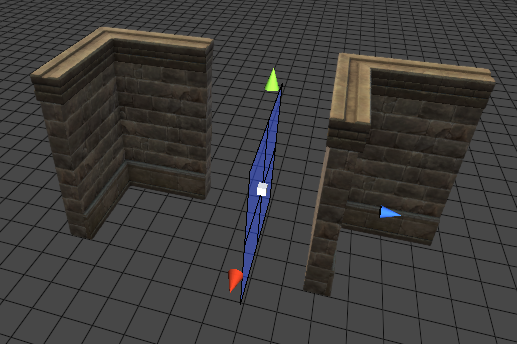
Although this may sometimes be what you need, most of the times this will probably be incorrect. What you will need is something like this:
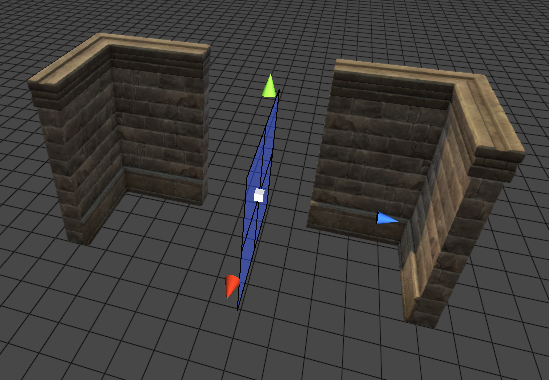
And this can be accomplished by checking the Mirror rotation toggle.
When the Mirror rotation toggle is checked, the plugin will have to set the scale of the object to a negative value along one if is local axes. This means that if you use physics, you might get the following warning show up in the console window:

This is meant to inform you that in some situations the negative scale can cause issues with the collision detection. For the most part, you can safely ignore this message.
However, in case you are using objects whose box colliders have their center offset from the mesh such that the collider sits on one side of the mesh, issues can indeed arise.
For example, the following image shows an example of a situation where negative scale can cause issues:
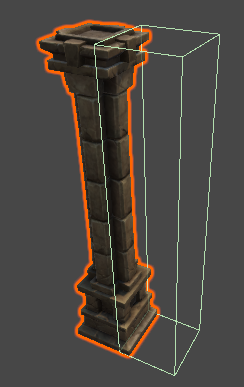
Note:The box collider center has been offset along the X axis intentionally for the purposes of this discussion.
Note how the box collider sits right next to the actual mesh object. Now, if we were to set the scale of the object to -1 along the X axis, the position of the box collider would be flipped:
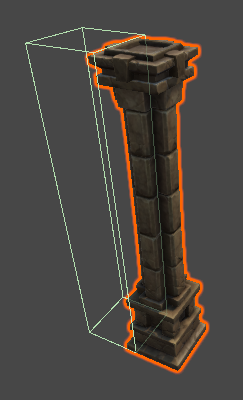
This means that you were expecting the box collider to be sitting to the right, the negative scale has flipped it on the other side without you being aware of it and collisions would no longer happen as expected.
Object Spawn Mirroring
In order to use the mirror gizmo in Spawn Mode, switch to a spawn mode that supports mirroring and activate the mirror gizmo. From the on, every object spawned using that tool will be mirrored accordingly.
The next image shows an example of using the mirror gizmo using the Segments Spawn mode:

In the next example Box Spawn is used and the mirror gizmo has 2 planes:
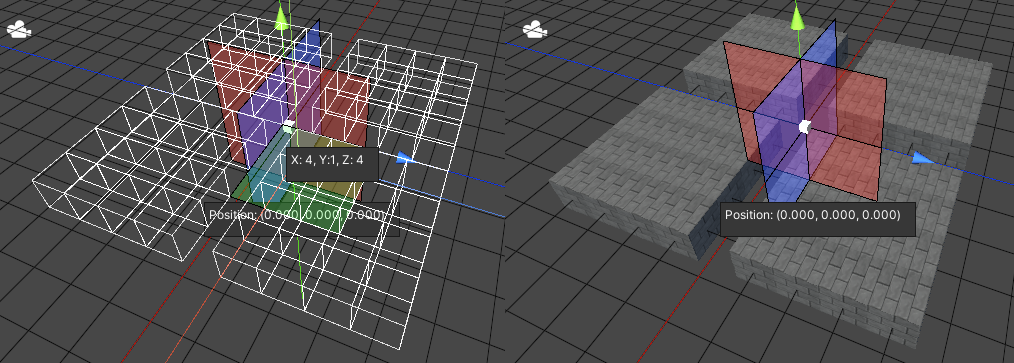
Mirroring is more restricted when using it with Tile Rule Spawn. The mirror gizmo doesn’t have rotation handles and you can’t rotate the mirror in any way. Also, the mirror gizmo settings are unique to each tile rule grid.
Also, if you mirror vertically, placing ramps may produce unexpected results:
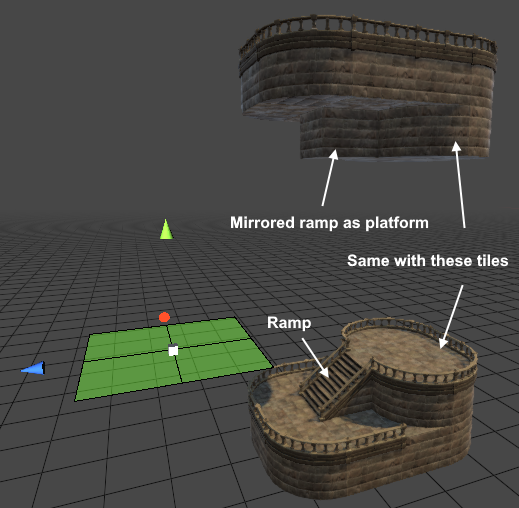
Due to the nature of mirroring, the mirrored ramp tile is placed below the upper tiles and it becomes a platform. The same happens to the tiles that the ramp is connected to. They are all turned into platforms. For this sort of environment, mirroring along the vertical axis doesn’t make much sense. You can however, mirror along the horizontal axes (X & Z axes).
Vertical mirroring might be useful if you were using the Tile Rule Spawn tool with tile blocks.
Selection Mirroring
In order to mirror the selected objects, activate the mirror gizmo and then press [M] on the keyboard.
Integer Patterns
An integer pattern is simply a collection of integer values such as <1, 2, 3, 2, 1> for example.
They are used with:
Segments Spawn - a pattern defines the height of each stack inside the segment chain (height mode must be set to Pattern);
Box Spawn - a pattern defines the height of the box shape along a certain direction (height mode must be set to Pattern);
Tile Rule Spawn - available for the segments brush (height mode must be set to Pattern);
Creating an Integer Pattern
Open Tools > GSpawn > Windows > Integer patterns…
The following window will appear on the screen:
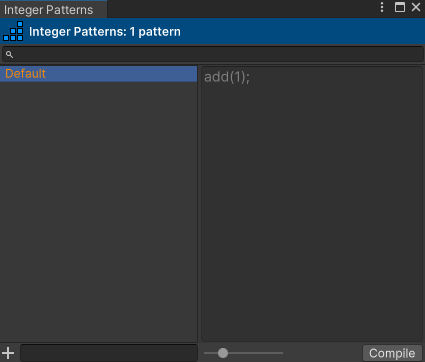
Enter a name in the text field at the bottom left and click on the plus icon to create a new pattern.
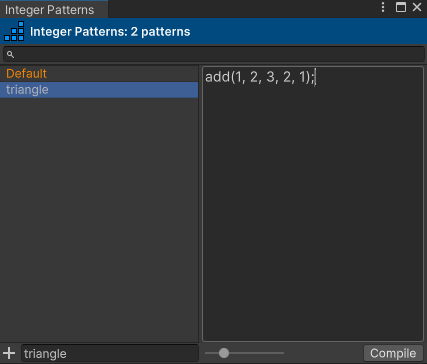
In the image above a pattern called triangle was created. In the right pane, we can see the pattern syntax.
Press Compile to compile the pattern. If there are no syntax errors, the pattern is now ready to be used. You need to press Compile whenever you make changes to the pattern.
Let’s see what happen if we use this with Segments Spawn:
activate the Segments Spawn mode;
set the Height mode to Pattern;
set the Pattern field to triangle;
This is the result we get:
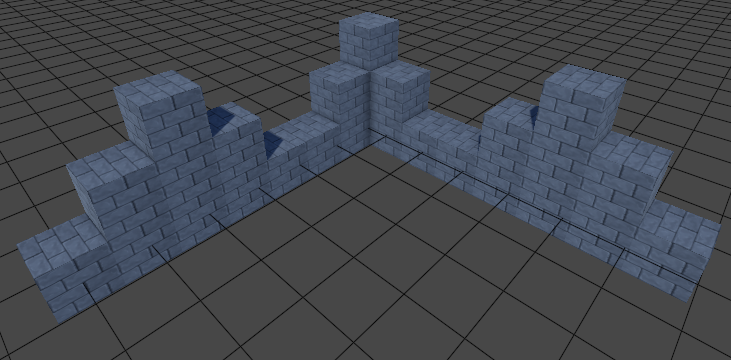
Notice how the integer pattern is used to control the height of each stack of objects.
Wherever patterns are used (Segments, Box, Tile Rules), there is a Wrap mode field available in the Inspector.
The Wrap mode field controls what happens when exceeding the number of values inside the pattern. Patterns will most likely be quite short, but the structures you build, will probably be a lot longer. Settings the Wrap mode to Repeat will cause the height pattern to wrap around. In the image above, the pattern repeats 3 times.
Setting the Wrap mode to Clamp will cause the plugin to use the last value in the pattern when no more values are available.
You can also mirror the pattern by setting the Wrap mode to Mirror.
Integer Pattern Syntax
In order to construct a pattern, you need to write ‘code’ in the right pane inside the pattern window.
The add command appends a sequence of values to the pattern and we have already seen it in action.
An expression produces a sequence of values. In the previous example, the expression is a list of values such as 1, 2, 3, 2, 1 separated by comas.
In order to add values to a pattern you need to write add(expr); (note the semicolon) where expr is a valid expression that produces a sequence of integer values.
Here are a few examples:
add(3, 2, 2, 3);
add(isoTriangle(4));
The isoTriangle expression creates and isosceles triangle and the argument (4 in this case) represents the triangle height. The pattern produced is <1, 2, 3, 4, 3, 2, 1>.
add(isoTriangle(-4));
Same as above, but produces an upside down triangle: <-1, -2, -3, -4, -3, -2, -1>;
add(steps(5, 2, false));
The steps expression can be used to create a stair-like pattern. The first argument (5) represents the number of steps, the second argument (2) represents the step length and the last argument must be set to either true or false. false means the stairs will grow upwards. true means the stairs will grow downwards. The pattern produced in this example is <1, 1, 2, 2, 3, 3, 4, 4, 5, 5>.
You can add an offset to an expression: add(isoTriangle(4) + 3);
This produces <4, 5, 6, 7, 6, 5, 4>:
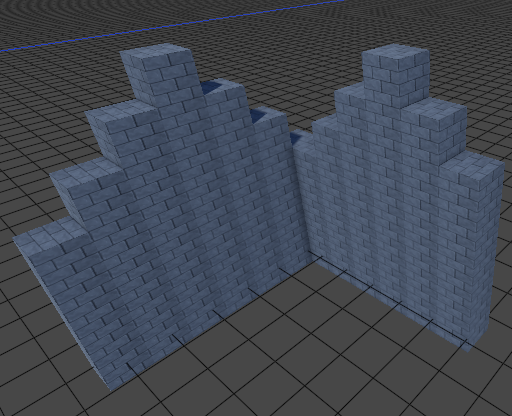
Negative offsets are also allowed: add(isoTriangle(-4) - 3);
This produces:

Another example: add({1, 2, 2, 2, 4} + 2);
Produces:
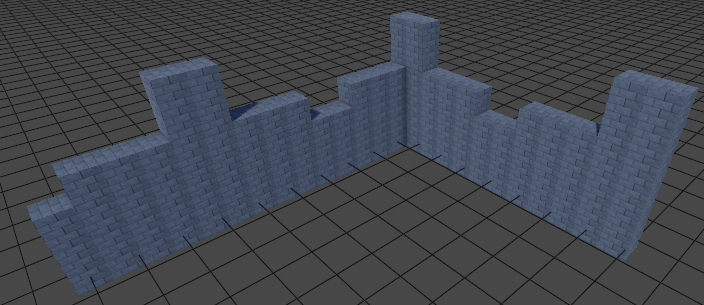
Note:Instead of using offsets when defining the pattern, you can also hold down [SHIFT] and use the mouse scroll wheel to offset the patterns up and down. This is a much better approach because it makes the patterns less restrictive (i.e. when you encode an offset inside the pattern it is always there and you can’t change it unless you recompile the pattern).
Integer Range Prefab Profiles
An Integer Range Prefab Profile holds a collection of prefabs where each prefab has 2 associated fields called Min and Max. These 2 fields define an integer range.
This is useful when working with the Segments & Box spawn tools when the Prefab pick mode is set to HeightRange.
Creating an Integer Range Prefab Profile
Open Tools > GSpawn > Windows > Integer Range Prefabs…
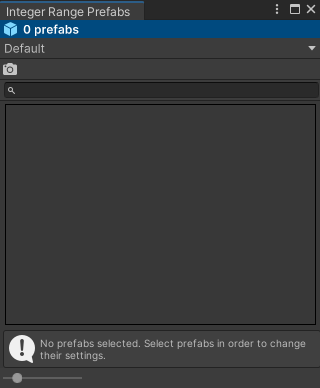
Click on the drop-down that says Default and create a new profile. The next image shows an integer range prefab profile with some prefabs assigned to it:

The prefabs were assigned by dragging them from the Prefab Manager window and dropping them onto the integer range prefab profile window.
The Used field can be used to temporarily ignore/disable prefabs. When Used is unchecked, the corresponding prefab(s) will not be picked.
Using Integer Range Prefab Profiles
This type of profile can be used with the Segments and the Box spawn tools. For example, using the profile defined earlier, we can get the following result when using the Box Spawn tool:
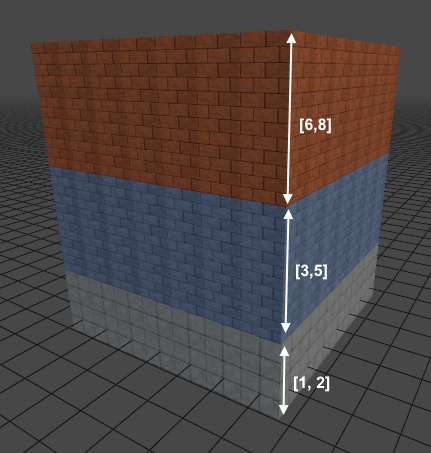
The prefabs were assigned the following height ranges (from left to right as they appear in the profile):
[0, 2]
[3, 5]
[6, 8]
These numbers represent the height offset that each object has inside the box shape.
Note:The value 0 is always treated as ‘no object’ when using the Segment and Box spawn tools. So even though the first prefab has a range of [0, 2] only the values 1 & 2 are actually taken into account.
The Default Pick Prefab
Sometimes it may be useful to define a default pick prefab to handle situations where an integer value is used to pick a prefab but none of the prefab ranges include the integer value. For example, if you were to use the Box Spawn tool and create a box that has a height of 9, but no prefab has a range that includes this value, you could mark one of the prefabs as the default pick prefab. If no such prefab is available, no objects will be spawned at height offset 9.
The next image shows the button that needs to be enabled in order to mark a prefab as the default pick prefab:
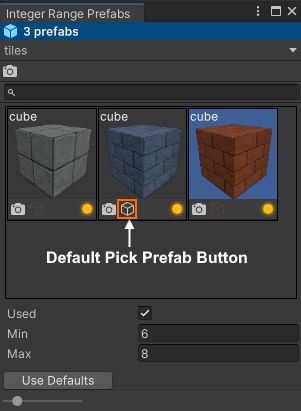
Only one default prefab can be used per profile.
Random Prefab Profiles
A Random Prefab Profile holds a collection of prefabs where each prefab has a probability value associated with it.
This is useful when working with the Segments & Box spawn tools when the Prefab pick mode is set to Random. Random prefab profiles are also used with the Physics Spawn tool.
Creating a Random Prefab Profile
Open Tools > GSpawn > Windows > Random Prefabs…
A new window will appear on the screen. Click on the drop-down to create a new profile and drag and drop prefabs from the Prefab Manager window:
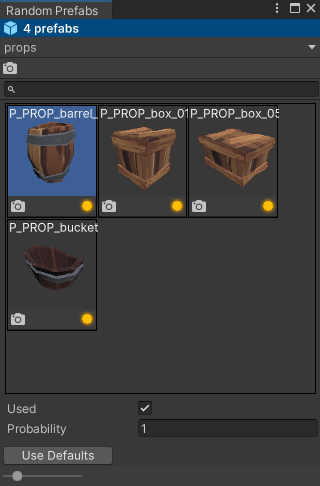
The image above shows a props profile which contains a few prefabs that could be used with Physics Spawn.
Use the Probability field to control how likely a prefab is to be picked. The Used field can be used to temporarily ignore/disable prefabs. When Used is unchecked, the corresponding prefab(s) will not be picked.
The Scene Grid
The scene grid is used for snapping objects. If you plan on building modular environments, it is important to establish a proper grid cell size.
Open Tools > GSpawn > Grid Settings…
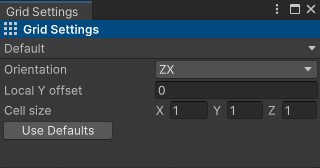
The default cell size is set to 1 for all axes. This is value works well with prefabs whose size along X and Z are whole numbers such as 3.0, 4.0 etc. However, if you are working with prefabs whose size have a fractional part such as 2.5 or 3.5, you should set the grid cell size to a lower value such as 0.5 or 0.25.
Picking a Grid Cell Size
Start with a grid cell size of 1 along all axes. Try to test it out by snapping a bunch of wall/floor pieces together. If the pieces don’t connect to each other as they are supposed to, then follow the next steps:
check if the art pack you are using comes with a readme file or doc. It’s possible to find the cell size you should be using written in those documents. If not:
make sure the spawn guide uses one of the main building-block pieces such as a wall corner or floor;
press [K] on the keyboard. This will automatically set the grid cell size along the X and Z axes to the size of the prefab;
check the cell size in the Grid Settings window. If the cell size has a 0.5 fractional part (e.g. 1.5, 3.5), set the X & Z cell size to 0.5. For numbers that use other fractional parts (e.g. 1.25, 3.75) set the X & Z cell size to 0.25.
Changing the Cell Size
You can also change the cell size by holding down [CTRL + SHIFT + ALT] and use the mouse scroll wheel. The X & Z cell size will change in increments of 0.25 units. A label will appear in the middle of the screen showing you the current grid cell size:

The Y/Vertical Cell Size
The cell size along the Y axis is not something you can see in the scene view. But it is used during modular snapping when moving the spawn guide up/down using the hotkeys. The spawn guide will be moved in increments of the Y cell size Also, when objects are snapped to the grid, their position will also snap along the Y axis.
Generally, you can leave this to 1.
Moving the Grid Up/Down
You can change the position of the grid along its local Y axis, using the Local Y offset field inside the grid settings window. You can also use the [ [ ]** and **[ ] ] keys to move the grid up/down in increments of the Y cell size.
You can also hold down [G] and left-click on an object to snap the grid to the position that lies under the mouse cursor. Holding down [G] and double-clicking will snap to object bounds extents. This works as follows:
if the cursor lies above the lower half of the object, it will snap the grid to sit on top of the object;
if the cursor lies below the upper half of the object, it will snap the grid to sit below the object;
This functionality can be useful when working with multistory environments.
Object Selection
This mode allows you to work with existing objects in the scene, select them manipulate them using different tools.
Note: Objects that belong to a tile rule grid can not be selected.
To activate this mode, click on the second button from the left in the main toolbar or just press [2] on the keyboard.

The Gizmos Toolbar
The following image shows the gizmos toolbar that becomes visible when the Object Selection mode is active:

The buttons are listed below, from left to right together with any applicable hotkeys:
move gizmo [W];
rotation gizmo [E];
scale gizmo [R];
move/rotate/scale (universal) gizmo [T];
extrude gizmo [U];
mirror gizmo [CTRL + Q];
transform pivot;
transform space;
Note:The move, rotate, scale & universal gizmos support snapping by holding down the [CTRL] key. The snap values can be changed using Unity’s UI:

Click-Select
You can left-click on an object to select it. Hold down [CTRL] and left-click to append to the current selection or deselect already selected objects.
When you click on a game object is an instance of a prefab, the entire prefab hierarchy is selected.
The Unity Editor allows you to click on the same object a second time to select the actual child object which was clicked on. This functionality is disabled by default in GSpawn, but you can enable it by opening Edit > Preferences window. Click on the GSpawn > Object Selection item in the left pane and check the Allow child select toggle:

The reason why this functionality is turned off by default is that it can sometimes be very easy to make mistakes. For example, you might want to use surface snapping to snap the hierarchy of a prefab instance to a terrain surface. But you may have accidentally clicked on one of the child objects and selected it. If that child object is part of an LOD group, you will end up changing the position of a single LOD object while all others remain in the same place. This can cause weird behaviors to appear. Another example is accidentally selecting a child object and using the extrude gizmo when in fact you wanted to extrude the entire hierarchy.
Multi-Selection Tools
Multi-selection allows you to select multiple objects at once using different selection tools.
Below the gizmo toolbar, there is another toolbar which allows you to pick the multi-selection tool you would like to work with:

The following tools are available (from left to right in the toolbar):
Selection Rectangle [SHIFT + 1] - select objects using a 2D rectangle;
Selection Segments [SHIFT + 2] - select objects using a chain of 3D segments;
Selection Box [SHIFT + 3] - select objects using a 3D selection box;
Selection Rectangle
Left click and drag the mouse to draw a rectangle on the screen. Objects which are fully overlapped by the rectangle will be selected.
Holding down [SHIFT] while dragging, will deselect the objects.
Selection Segments
In order to use:
move the mouse to establish a starting point;
left-click to start;
Each successive click adds a new segment.
Actions:
[SHIFT + left click] - commit;
[SHIFT + right click] - remove last segment (i.e step back);
[ESCAPE] - cancel;
The next image shows a situation where this tool might be useful:
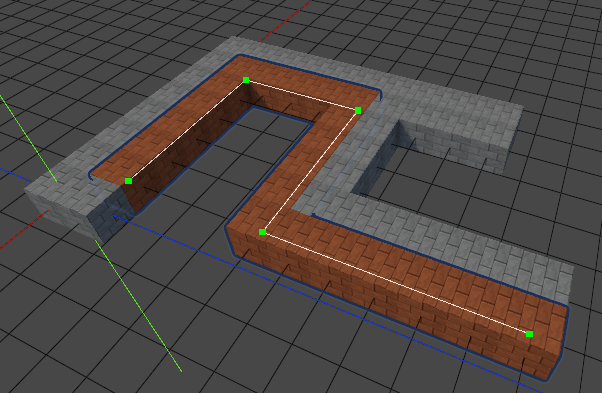
If you wanted to delete the brown bricks, you would have to manually click on each of those bricks. Using the selection rectangle wouldn’t work as it would also select the gray bricks. With the segments tool however, we can draw a selection path and cover the brown bricks in just a few clicks.
When moving the mouse, the segment end points will snap either to the grid or to object bounding volume centers.
When snapping to the grid, the snap point will be one of the cell corners or the cell center point depending on which one is closer to the mouse cursor.
Selection Box
This tool can be useful for selecting blocks of objects/tiles. Very handy when working with tiles.
In order to use:
move the mouse to establish a starting point;
left-click to start;
move the mouse to extend the box horizontally;
left-click to start vertical extension;
move the mouse to extend vertically;
left-click to commit;
Pres [ESCAPE] to cancel.
The next image shows a tile block being selected using this tool:
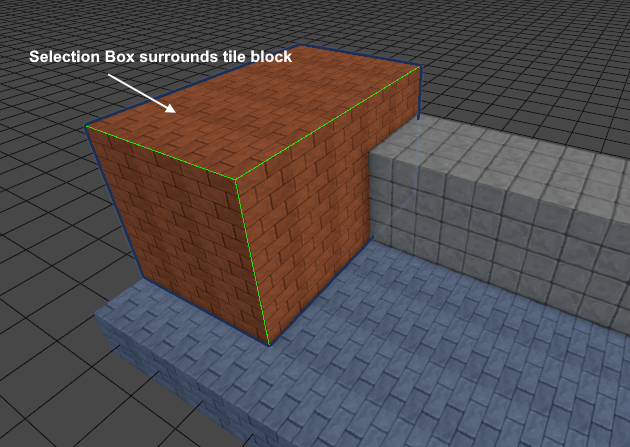
Prefab Replacement
When working in Selection mode, a very useful feature is the prefab replacement mechanism which comes in 3 flavors:
select objects, hold down [ALT] and left click on a prefab in the Prefab Manager window - this will replace the selected objects with the prefab you clicked in the manager UI;
select objects, hold down [ALT] and left click on a prefab instance in the Scene View - this will replace the selected objects with the prefab you clicked in the scene;
select objects, select prefabs in the Prefab Manager, hold down [CTRL + ALT], and left click on the prefab previews - this will replace the selected objects with prefabs that are picked randomly from the group of selected prefabs in the Prefab Manager;
The Selection UI Toolbar

The Selection UI Toolbar allows you to enable different kinds of UIs for different purposes:
Settings - contains different types of settings (e.g. selection, extrude gizmo, mirror gizmo);
Transform Tools - this UI contains a series of settings and action buttons that pertain to different types of tools that can be used to manipulate/transform selected objects;
Misc - miscellaneous;
Settings
Selection Filters
The selection filters allow you to specify the types of objects that can be selected either by clicking on them or using the multi-select tools:

By default only mesh and sprite objects can be selected and these can never be disabled.
Transform Tools
Modular Snapping
You can select multiple objects and use modular snapping to snap them to the grid. Modular snapping was already discussed in Modular Snap Spawn so it won’t be covered here.
The only difference is that you can control multiple objects at once.
In order to start snapping, press [D]. This enables the modular snap session and allows you to make the necessary changes. Left-click to commit.
Surface Snapping
Surface snapping allows you to select multiple objects and snap them to terrains or mesh surfaces. This is the same as using the Props Spawn tool. The difference is that you can snap multiple objects at once.
In order to start snapping, press [C]. This enables the modular snap session and allows you to make the necessary changes. Left-click to commit.
Projection
Projection allows you to project the selected objects on the scene grid or onto other objects.

To project onto the scene grid you can press the Project on grid button or press [SHIFT + G].
To project onto another scene object you can press the Project on object button or press [SHIFT + F]. Next you have to left click on an object in the scene.
The Project as unit field treats all object as a unit (i.e. single entity) when projecting. This means that if checked, objects belonging to different hierarchies will retain their relative positions post-projection. Otherwise, they are treated independently and projected individually on the projection surface.
The Half space fields allows you to select where you would like to project: in front or behind. Projecting behind may sometimes be useful for example, if you wanted to project an object such as a chandelier onto a ceiling.
Note:When projecting on meshes, the projection will happen along the normal of the triangle that was picked with the mouse cursor.
Vertex Snap
Vertex snapping allows you to snap objects using their vertices. This is similar to Unity’s own vertex snapping functionality.
To use:
hold down [V];
move the mouse to pick a vertex belonging to one of the selected objects;
left-click and drag to snap to nearby object vertices or grid;
Box Snap
Box snapping is almost similar to vertex snapping, but instead of using object vertices, the object bounding volume corners and center are used instead.
To use:
hold down [B];
move the mouse to pick a box corner or its center (depending which one is closer to the mouse cursor);
left-click and drag to snap to nearby object bounds or to the grid;
Misc
Selection Grow
Consider the following small scene:
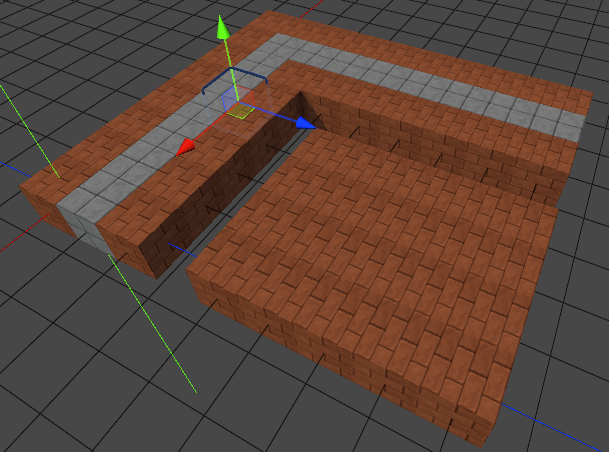
One of the gray tiles is selected and we would like to extend the selection to include all the tiles in the L shape. Pressing [SPACE] will do just that:

If we wanted to constrain the selection to include only prefabs that belong to the original selection, we can change the grow settings by checking the Prefab constraint field:
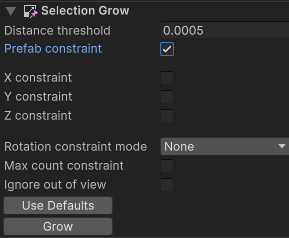
Assuming we started with a single gray tile selected, this time around, the grow operation will only include the gray tiles:
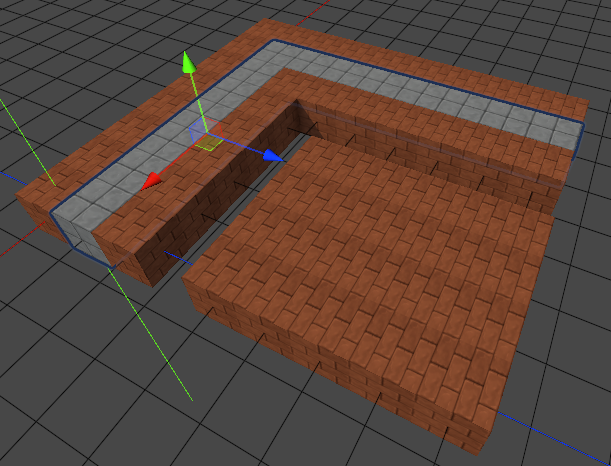
The Distance threshold allows you to specify the distance tolerance between objects. For example, let’s assume that we also wanted to select the brown tiles in the square shape in the image above. We would set the distance tolerance to 1 and press Grow (assume that the prefab constraint is either unchecked or that a gray and brown tile were initially selected).
The X/Y/Z constraint toggles allow you to constrain the directions in which the grow operation can extend.
Creating Prefabs From Selected Objects
You can easily create prefabs from the selected objects by following these steps:
select objects in Selection Mode;
open the Prefab Library window;
click on the Create prefab… button:
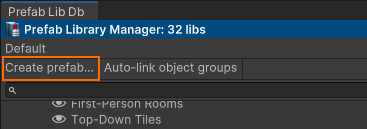
a new window will appear on the screen:

Once all settings are configured, press the Create button. This will create the prefab in the specified folder. If a prefab with the same name already exists, you will be asked if you wish to overwrite it.
Prefab creation fields:
Prefab name - the name of the prefab asset;
Destination folder - the folder in which the prefab asset will be placed. You can enter the name manually, or you can drag and drop a folder in the text fields;
Pivot - allows you to specify where the pivot of the resulting prefab will reside;
Pivot object name - if this field is empty, the pivot will be calculated using the bounding volume of the entire prefab hierarchy. Otherwise, this name should be the name of an object whose bounding volume will be used for the pivot calculation. This field is mostly useful then the Pivot field is set to Tile Rule;
The image below shows 3 objects which were selected in order to create a bridge tile rule:
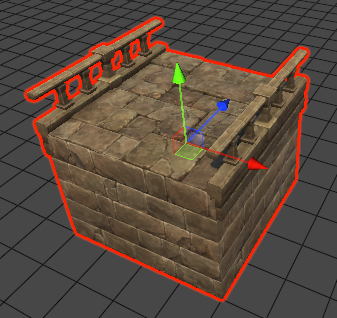
When using this functionality to create tile rules, the Pivot should be set to TileRule and the Pivot object name field should be set to the name of the object that would normally sit on the tile rule grid surface. In the image above, this is the floor object whose name is Base_03. If Pivot object name is empty, the plugin will pick the object with the largest bounding volume and use that for calculating the pivot.
Extrude Gizmo
The extrude gizmo allows you to duplicate objects along a certain direction.
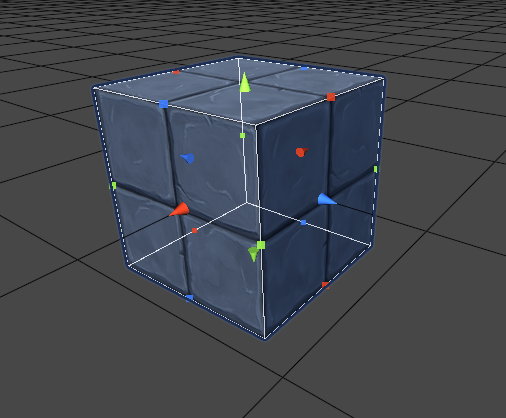
The cone handles allow you to extrude along one axis while the small dots allow you to extrude along 2 axes at once. Here is an example of extruding along one axis:
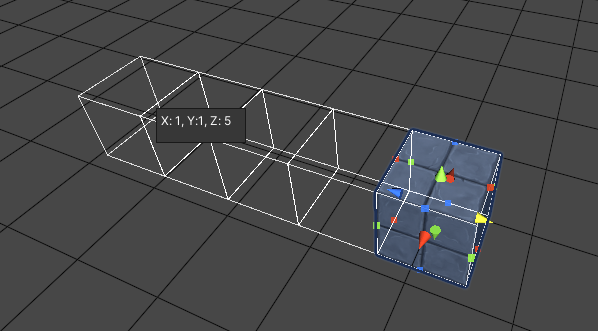
Here is an example of extruding along 2 axes at once:
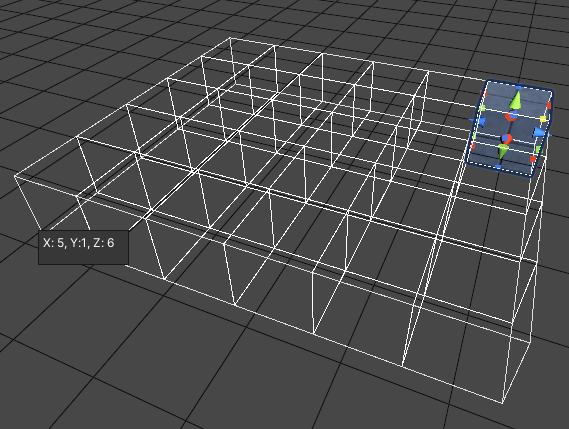
Post extrusion, the objects that were spawned as a result, will be added to the selection. This allows you to ‘chain’ extrude operations.
In the image below, the object was first extruded along the red axis, then the entire result was extruded along the blue axis:
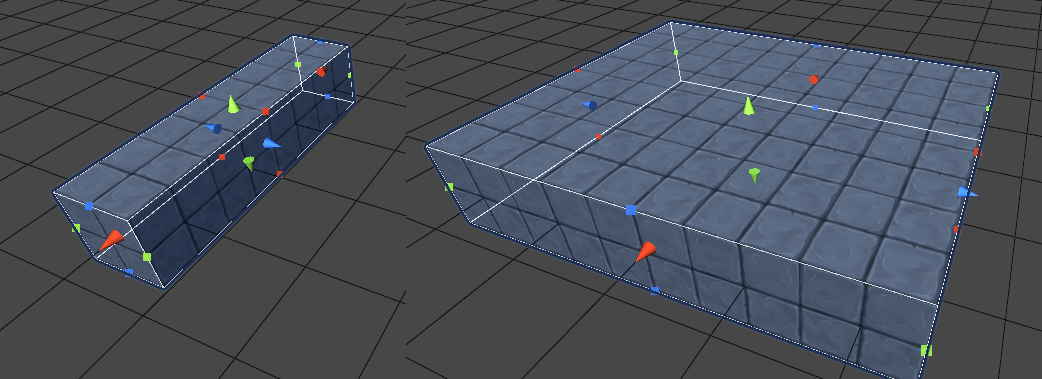
Non-Selectable Objects
The following objects can not be selected using the selection tools:
objects that don’t satisfy the type filter criteria;
the GSpawn game object;
objects that belong to layers for which picking was disabled:

objects for which picking was disabled inside the hierarchy window:

children of a tile rule grid;
Selection Transfer
The plugin maintains its own list of selected objects. Sometimes it may be useful to select a bunch of objects using the plugin interface and then transfer the selection to Unity’s selection interface or vice versa. For example, you might wish to modify component properties which can only be done using Unity’s standard interface.
You can press [ALT + T] to quickly perform this transfer operation.
Object Erase
The Object Erase mode allows you to erase objects in the scene using different erase tools.
Note: Objects that belong to a tile rule grid can not be erased.
To activate this mode, click on the third button from the left in the main toolbar or just press [3] on the keyboard:

Erase Tools
The following erase tools are available:
erase cursor [SHFIT + 1] - erase objects using the mouse cursor;
2D erase brush [SHIFT + 2] - erase objects using a 2D circular brush;
3D erase brush [SHIFT + 3] - erase objects using a 3D circular brush;
You can change the radius of the erase brush from the UI or you can use [CTRL + scroll wheel] for the same purpose.
The Cursor and 2D Brush are useful when you would like to delete large amounts of objects quickly in a certain area.
The 3D Brush can be great for clearing areas on terrains or even floors or walls. For example, you might have a an area of the level that contains a series of decorations on a flat wall. You could place the brush on the wall and drag it around to clear up the area.
The next image shows an example of using the erase brush to erase a bunch of props:
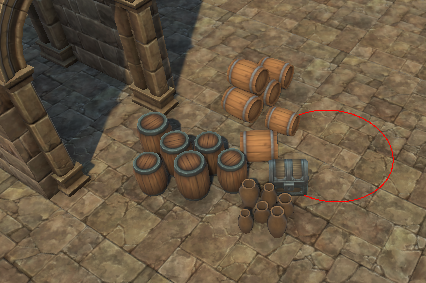
the 3D brush is also very useful when used in conjunction with the Scatter Brush Spawn tool.
Erase Mask
Sometimes you may want to prevent certain objects from being erased. This is achieved by masking them:
switch to Selection Mode;
select the objects you wish to mask;
switch to Erase Mode;
click on the Mask selected button:

The selected objects will be added to the Erase Mask list as shown above. In this example, a single object called Platform was masked.
If you wish to unmask objects, select them in the mask list and press [DELETE] to delete them.
Non-Erasable Objects
The following objects can not be erased using the erase tools:
masked objects;
the GSpawn game object;
objects that belong to layers that have been marked as non-erasable;
terrain mesh objects;
spherical mesh objects;
objects for which picking was disabled inside the hierarchy window:

children of a tile rule grid;
Erase Cull Plane
The Cursor and 2D Brush tools support a feature called erase cull plane. This can be used in situations where you would like to erase a bunch of objects but ignore the objects behind them.
You can enable the cull plane in 2 ways:
[SHIFT];
OR
check the Enable cull plane by default field in the Inspector. In this case [SHIFT] will disable the cull plane (i.e. works in reverse);
Note:The cull plane works well with simple objects such as tiles, but they don’t play too well with more irregular meshes because these can have many different triangles pointing in all sorts of directions and it becomes harder to predict the cull plane in that case.
Erase Height
When using the 3D Brush you can specify a height value that will essentially turn the circle into a cylinder. This is useful for erasing objects that sit slightly above the surface on which the brush is sitting. It is a sort of tolerance value.
A vertical line can be seen going out of the center of the brush and extending along the circle plane normal. This acts as an indicator for the height:
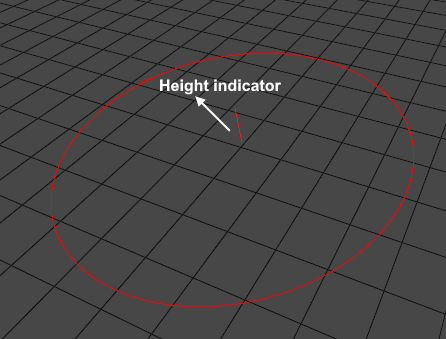
Object Groups
Object groups are a great way to organize your scene. Instead of spawning objects at the root level you might wish to organize your scene into a more logical structure.
An object group is simply a scene object that acts as a container for child objects and it can be used to organize objects in categories.
For example, the following hierarchy of object groups might be used to organize the scene:

This is just an example, but this hierarchy could be used to create an apartment scene. Prop objects could go into the og_props groups, floors could go inside og_floors and so on.
Note:The og_ prefix is just a convention. You can name the object groups as you wish. However, object groups can not have duplicate names. If you attempt to create an object group using a name that is already used, the plugin will append a suffix to the name.
Creating Object Groups
Open Tools > GSpawn> Windows > Object Groups…
The following window will appear on the screen:
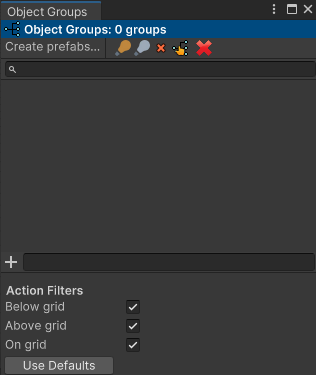
One way to create object groups is by entering a name in the bottom text field and then pressing the plus icon next to it.
Another way, is to create empty objects using Unity’s interface (e.g. right click in hierarchy window and press Create Empty) and then dropping those objects inside the object group window. The next image shows the same window after the object group hierarchy discussed previously was dragged and dropped into the object group window:

In this example, the og_apartment group and all its children were first selected in the hierarchy window and then dropped into the object group window. If only og_apartment was selected, then its children would not be added to the object group window and they would not be recognized as object groups.
Deleting Object Groups
In order to delete object groups, select them inside the Object Group window and press [DELETE]. This will NOT delete the scene objects. It merely tells the plugin to stop treating them as object groups.
If you wish to also delete the scene objects, press the red X button in the top toolbar. This will also delete the scene objects.
Note:It is recommended to avoid deleting object groups using Unity’s interface (e.g. selecting them in the hierarchy view and deleting them from there). This can cause errors to appear in the Console window.
Object Group Actions
To the right of each object group, the following buttons can be used to perform different actions (from left to right):
activate the object group children;
deactivate the object group children;
highlight the object group in the hierarchy window;
delete immediate children (only non-object group children are deleted);
The top toolbar also has a few actions available:
Create prefabs… - opens up a new window which will allow you to create prefabs from each top level object group. In this example, a prefab would be created for the entire og_apartment hierarchy. This is useful when the same object group hierarchy must be used in more than one scene;
activate/deactivate selected object groups;
delete children of selected object groups;
assign selected objects to selected group.;
delete selected object groups - when using the [DELETE] key to delete object group items from the object group window, the objects will not be deleted from the scene. The plugin simply stops treating them as object groups. However, pressing this button will also delete the objects from the scene;
Activating/deactivating object groups can be very handy when working on certain types of levels such as an apartment or multistory environments because it allows you to toggle the visibility of different parts of the scene (e.g. floors, walls etc) to make certain areas more accessible.
Action Filters
At the bottom of the Object Group window, there is a UI section called Action Filters. These filter apply to the activate/deactivate children buttons to the right of each object groups.
Filters are useful in situations where you are dealing with multistory environments. For example, you might have an object group called og_floors that contains all the floor objects in the scene. Let’s assume that the environment you are building has 3 floor levels. You may wish to place props on the second level but hide the first and last levels to increase visibility. In order to do this, you can follow these steps:
hold down [G] and left click on the second level floor objects. This will snap the grid so that the floors are resting on the grid surface;
in the Object Group window, uncheck the On grid toggle and press the deactivate group children button to the right of the og_floors group:

This will deactivate all floor objects in the scene which reside either below or above the grid. The ones that rest on the grid surface will not be affected and you can now work with them as needed.
Linking Object Groups to Prefabs
After the object groups have been created, you must link prefabs to object groups. This will ensure that whenever a prefab is spawned, the object will be made a child of the linked object groups.
Make sure both the Object Group and Prefab Manager windows are open.
Next, follow these steps:
select prefabs in the prefab manager;
drag and drop the prefabs onto one of the object group items in the object group window OR drag and drop an object group onto the selected prefabs;
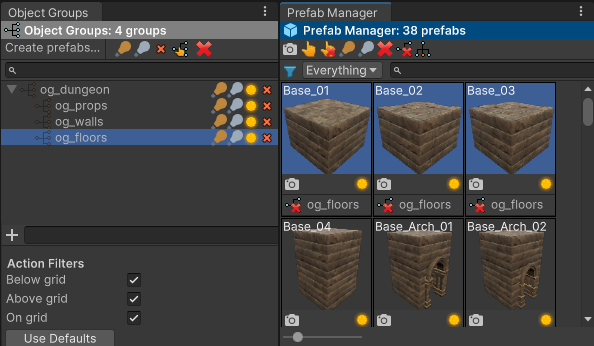
In the image above, 3 prefabs were selected in the prefab manager and the og_floors object group was assigned to those prefabs. When a prefab is linked to an object group, the name of the object group is displayed below the prefab preview. You can press the small button with the red X to the left of the group name in order to unlink.
At this point, these 3 prefabs are attached to the og_floor object group and whenever they are spawned in the scene they will be made children of this object.
In the top toolbar of the Prefab Manager window, you can see the following buttons (among others):

The first button will unlink all selected prefabs from their object groups.
The second button can be used in situations where you might have spawned prefabs in the scene and decided to create object groups later. It will assign the instances of the selected prefabs as children of the linked object groups. If the selected prefabs are not linked to an object group they will be attached to the Default group if any. If no Default group is available, they will reside at the scene root.
Note:When using the Tile Rule Spawn tool, the prefabs will always be attached to the tile rule grid even if they are linked to an object group.
The Default Object Group
The default object group is useful when you are dealing with prefabs that you do not wish to assign to any specific object group, but at the same time you don’t want them to reside at the scene root.
When this is the case, create a new object group and left click on the icon to the left of the item in the object group window:
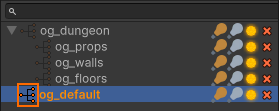
The image above shows a new object group that has been marked as the default object group.
From now on, any prefabs which are not linked to an object group, will be attached to og_default.
If you wish to unmark a group from being the default group, you can click on the highlighted button again. The button acts like a toggle.
Note:There can only be one default object group per scene.
Object Groups & Multiple Scenes
Object groups are not shared between scenes. When you link object groups to prefabs, those links only exist in the scene in which the linking occurs. When switching to a new scene, you will have to create new object groups and link again.
Note:Do not move object groups between scenes. This functionality is not supported.
There are 2 things you can do to make this process a bit faster:
use the Create prefabs… button in the Object Groups window. This will allow you to replicate object group hierarchies between different scenes. When creating a new scene, instantiate the prefab and drop the created hierarchy in the Object Group window;
in terms of linking groups to prefabs, there is a way to reuse the links from previous scenes. This is only useful when using similar object group hierarchies between scenes. Open up the Prefab Library window:
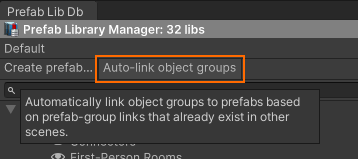
Now click on the Auto-link object groups button. This will traverse all the prefabs in all libraries and link each prefab to a group whose name matches one of the groups that exist in another scene.
Again, the last point only works when using similar object group hierarchies. Otherwise, you will have to link manually.
What you can do is to create a ‘universal’ object group hierarchy that contains all object groups that will be used across all scenes. For example:

With this arrangement, when you click on Auto-link object groups, the prefabs will always be linked to a valid group (provided that there was one assigned in the first place).
Object Layers
Open Tools > GSpawn > Windows > Object Layers…
This will bring up the following window:
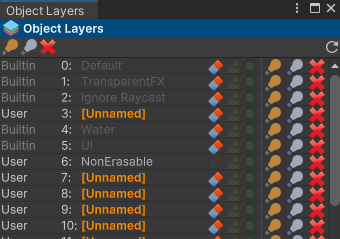
This is a list of all layers that Unity allows you to use. The difference is that each layer has a few properties and actions associated with it.
The first column of icons to the right of the layer name allow you to control layer properties:
erasable toggle - if on, objects that belong to these layers can be erased using the erase tool. In the image above, all layers are erasable except for the layer named NonErasable. You can see that its eraser icon is grayed out.
terrain mesh - if on, objects that belong to this layer are treated as terrain meshes;
spherical mesh - of on, objects that belong to this layer are treated as spherical meshes;
The second column of icons allows you to perform certain actions such as activate, deactivate and delete objects that belong to the corresponding layer.
You can change the name of a layer by double-clicking on a layer item in the list. [ENTER] to commit or [ESCAPE] to cancel.
Terrain Meshes
You may sometimes need to work with terrains that are stored as a mesh asset instead of a regular Unity Terrain. Maybe you used a modelling package to create your own terrain for example. The plugin needs to know when this is the case in order to ensure that certain types of functionality work as expected (e.g. surface snapping).
In order to tell the plugin that a mesh object has to be treated as a terrain, you have to follow these steps:
assign the terrain object to a special layer;
rename that layer to something meaningful (e.g. TerrainMeshes);
open Tools > GSpawn > Windows > Object Layers…
mark the layer (in this example TerrainMeshes) as a terrain mesh layer:
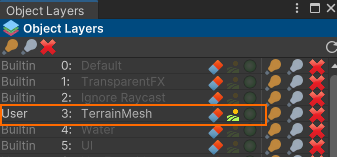
Terrain Up Axis
Unity Terrains always use the world up axis as their up axis. In case your terrain uses a different axis, you have to follow these steps:
select the terrain mesh object;
set its rotation to 0 on all axes;
the hills of the terrain will now be pointing along one of the world axes. Let’s assume that they point along the negative Z axis;
open Edit > Preferences… and find the GSpawn item hierarchy in the left pane;
click on the Object child item:
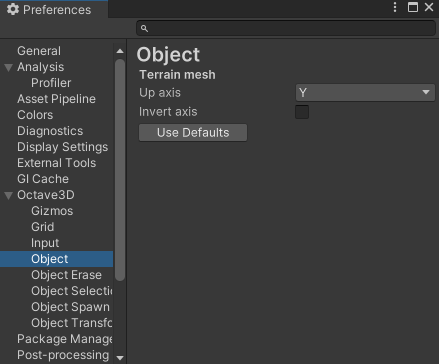
by default the Up axis is set to Y. Change it to Z;
check Invert axis because in this example we assume that the hills are pointing along the negative Z axis;
At this point you can rotate the terrain object as you wish and use it with surface snapping.
Spherical Meshes
If you wish to create scenes where the objects are placed on top of spheres, then you need to mark those sphere objects as Spherical Meshes. This allows the plugin to snap objects correctly across the surface of a sphere.
In order to tell the plugin that a mesh object has to be treated as a sphere, you have to follow these steps:
assign the sphere object to a special layer;
rename that layer to something meaningful (e.g. SphericalMeshes);
open Tools > GSpawn > Windows > Object Layers…
mark the layer (in this example SphericalMeshes) as a spherical mesh layer:

Mesh Combine
In order to reduce draw calls, you can combine meshes that share the same material. Open Tools > GSpawn > Windows > Mesh Combine…
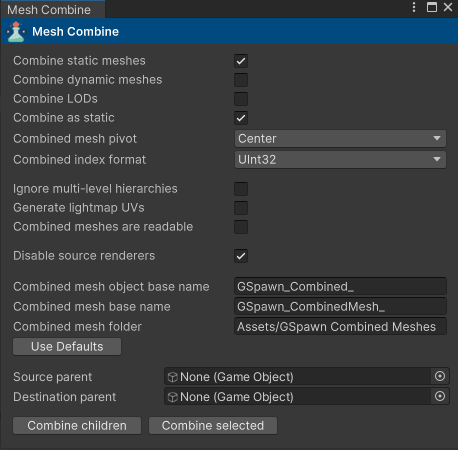
The fields are discussed below:
Combine static meshes - uncheck this if you wish to ignore meshes that are associated with objects that have been marked as static;
Combine dynamic meshes - uncheck this if you wish to ignore meshes that are associated with objects that have been marked as dynamic;
Combine LODs - if checked, meshes that have LODs will also participate in the combine process. Leave this unchecked if you want to ignore LOD meshes. When this field is checked, a new filed will appear that allows you to select the LOD index that will be picked for baking;
Combine as static - if checked, the combined mesh objects will be marked as static;
Combined mesh pivot - allows you to select the pivot of the combined mesh;
Combined index format - allows you to specify the index format (16 bit vs 32 bit) of the combined mesh indices;
Ignore multi-level hierarchies - if checked, only standalone objects will be combined. These are objects that don’t have parents and are not children of any other objects;
Generate lightmap UVs - check this if you are using lightmapping;
Combined meshes are readable - check this if you wish to read the combined mesh data from scripts;
Disable source renderers - if checked, the mesh renderers of the original mesh objects will be disabled when the mesh combine process is finished;
Combined mesh object base name - for each combined mesh, the plugin will create a game object to which the mesh will be attached. This is the object name’s prefix. The plugin will add the material name as well as a number such as 01 at the end;
Combined mesh base name - each combined mesh is saved as an asset and this is the name prefix of the mesh assets. The plugin will add the material name and a hash number;
Combined mesh folder - this is the name of the folder where all combined meshes will be saved to.
Source parent - this is the parent object that contains the meshes that you want to combine. When using object groups, you may wish to specify the top level object group to make sure all meshes that share the same material are combined in a single mesh;
Destination parent - this is the parent object that will house all combined mesh objects;
Press Combine children to combine all child objects of Source parent and store the result in Destination parent.
Press Combine selected to combine only the selected objects and store the result in Destination parent.
The Data Folder
When you install the plugin a Data folder will be created inside the GSpawn - Level Designer folder. This is where all the data is stored in the form of assets and this arrangement allows you to switch to different scenes without loosing the data.
This folder has to exist in the project in order for the plugin to be able to operate. If you decide to delete the Data folder, you will get the following message on the screen:
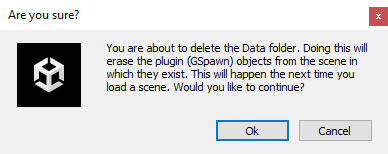
If you press Ok, all plugin objects (GSpawn objects) will be deleted the next time you load the scenes in which these objects exist.
Exporting Data
Although the data is maintained between scenes that belong to the same project, once you begin a new project all the data will be lost. However, you can export the data as a Unity package and import that package inside the new project.
Open Tools > GSpawn > Windows > Export Data…
The following window will appear on the screen:
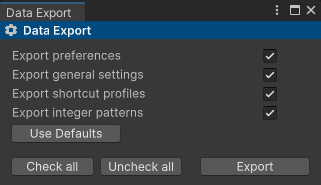
The toggles allow you to specify what data you would like to export. Most of these are self explanatory, maybe except for Export general settings. This refers to most settings that you can see in the Inspector UI. Here are a few examples:
modular snap settings (spawn mode or selection mode);
surface snap settings (spawn mode or selection mode);
mirror gizmo settings (spawn mode or selection mode);
selection settings;
erase settings etc;
You can not export the following:
prefab library profiles;
object groups;
curves;
erase masks;
any other data that references assets or scene objects;
Hints & Gotchas
don’t attach object groups to objects that can be erased (e.g. meshes, sprites etc). This can lead to accidentally deleting object groups when using the erase brush. Instead, try to make sure all object groups are either attached as children of other groups or have no parent at all;
don’t move object groups between different scenes. The plugin uses a global id to store them internally and this id seems to change when the object is moved to a different scene. This can cause unexpected results;
when combining meshes, if the Generate lightmap UVs toggle is checked, the mesh combine process can be slow. If you see the progress bar getting stuck at some point, don’t be misled into believing that the plugin crashed. If you wait a bit, you will see the progress bar coming back to life;
when combining meshes, pressing the Combine children or Combine selected button will sometimes display a message box saying “There were no meshes combined.”. When this happens you should check the Combine static/dynamic meshes fields. If both are unchecked, no object can participate in the combine process. Also, it is possible for example that you might be dealing with static meshes only, but the Combine static meshes field is unchecked. Same with dynamic meshes;
if you are using a skybox material in the Lighting window inside the Environment tab, prefab previews will be affected by it. If this affects the quality of the prefabs, you should disable the skybox material, regenerate the prefab previews from Tools > GSpawn > Actions > Refresh Prefab Previews and then enable the skybox material again. If you find yourself adding and removing prefabs frequently, you might have to disable the skybox material until you finish working on your scene;
when using Curve Spawn, instead of using multiple lanes, it may sometimes produce better results to use prefabs made out of multiple objects arranged in different configurations (e.g. a prefab containing a few trees of different sizes bundled together). At the same time, try to make sure that the area covered by a single prefab is not too large. Large objects do not always project correctly onto surfaces such as terrains especially where steep surfaces exist;
when changing the color space, the console might get flooded with warning messages regarding an invalid render texture format. In order to fix this, switch to Play Mode and back. Whether these warnings appear or not, you will always have to refresh the prefab previews when you change the color space. In order to do this, click on Tools > GSpawn > Actions > Refresh Prefab Previews;
Known Issues
sometimes you can no longer use the window scrollbars. When this happens, resize the window that owns the scrollbar. The scrollbar should now work properly. If it still doesn’t work, switch to Play Mode and back;
if you are a programmer you will be compiling scripts quite often. After script recompile, it can happen that you can no longer move the scene view camera or perform other kinds of actions. If this happens, just click on an UI item (e.g. an item in the hierarchy view). This will solve the issue;
when saving the scene, you might sometimes see this message in the console:

However, this doesn’t seem to affect anything. It seems like this could be a known bug in Unity. More info here.
Mac users may not be able to drag and drop prefabs from the prefab manager onto other windows such as the Curve Prefab Profile window for example. If this happens, you can use the green arrow button which exists in all windows in which prefabs can be dropped from the prefab manager:
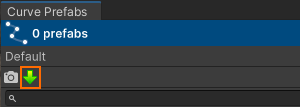
Simply select prefabs in the Prefab Manager and then click on the green arrow button to simulate the drag and drop operation.
Changelog
GSpawn - Level Designer 3.2.9
Features
Added [CTRL + SPACE + scroll wheel] shortcut for scrolling spawn guide prefab.
Added GSPAWN_ALWAYS_UPDATE_DATA_FOLDERS scripting symbol.
Improvements
Memory optimization when populating prefab library database.
Resources folder is now child of Editor folder.
Bug Fixes:
Fixed errors generated when invoking action menu items when no GSpawn object exists in the scene.
GSpawn - Level Designer 3.2.8.6
Features
Added button to delete obscured tiles when working with tile rule grids.
Improvements
Added button in object group window to simulate drag and drop on macOS.
Bug Fixes
Fixed error which would show up when attempting to drop prefab onto the Prefab Library Db Window, in empty space (i.e. mouse not hovering library item).
GSpawn - Level Designer 3.2.8.5
Bug Fixes
Fixed null ref exception when drag and dropping prefab folders in prefab manager UI.
GSpawn - Level Designer 3.2.8.4
Improvements
When prefabs are dragged from the prefab manager onto prefab library items, the destination library is no longer selected.
Added option for macOS users for using [ALT + right-click] to rotate prefab previews.
Bug Fixes
Fixed [SHIFT + X/Y/Z] in selection mode not calculating rotation center properly.
Fixed prefabs not being dropped on library hovered by mouse cursor.
GSpawn - Level Designer 3.2.8.3
Improvements
Pick spawn guide prefab key can now be configured from the Preferences window (GSpawn > Input).
Selection replace key can now be configured from the Preferences window (GSpawn > Input).
Bug Fixes
Fixed lag when switching to playmode caused data folder validation.
Fixed mouse scroll wheel not working on some systems.
Fixed no longer spawning object when [ALT] is pressed (i.e. camera orbit works properly).
GSpawn - Level Designer 3.2.8.2
Bug Fixes
Fixed prefab previews for LOD hierarchies not generated correctly.
Fixed selection wireframe not drawing correctly for child objects.
Fixed selection wireframe incorrectly drawing wireframe for invisible LODs.
Fixed selection gizmos obscured by selection wireframe.
Fixed selection rectangle not taking DPI settings into account.
Fixed selection outlines drawing as wireframe for unity versions newer than 2022.1.
Fixed tile rules evaluated incorrectly for certain tile rule configurations.
Fixed exception being thrown when spawning objects with curves.
GSpawn - Level Designer 3.2.8.1
Bug Fixes
Fixed middle inner/outer pillars would not spawn if no tags were assigned to them.
Fixed wall prefab profile not updating correctly when changing the state of the Truncate forward size toggle.
Fixed wall prefab profile incorrectly calculating the forward size causing the user to press the Refresh button needlessly.
Fixed exception being thrown when deleting selected objects while being manipulated via a transform session (e.g. modular snap, surface snap etc).
GSpawn - Level Designer 3.2.8
Improvements
Tags can now be assigned to PillarInnerCornerMiddle & PillarOuterCornerOuter pillar prefabs in a modular wall profile. This opens up the possibility of using different prefabs for the middle inner/outer pillars and it allows them to be picked correctly from the random prefab profile.
Bug Fixes
Fixed spawning incorrect type of pillar in certain situations when spawning modular walls.
GSpawn - Level Designer 3.2.7
Improvements
Improved modular wall pillar spawn when no inner/outer corner pieces are used (existing wall profiles that use pillars require pressing the Refresh button inside the Modular Wall Prefab Profile window).
Added 2 new pillars for modular walls: PillarInnerCornerMiddle & PillarOuterCornerMiddle.
GSpawn - Level Designer 3.2.6
Improvements
Added GSpawn - HDRP Integration PDF file inside the Docs folder.
Bug Fixes
Fixed null reference exception being thrown when pressing [K] to sync grid size when no spawn guide exists in the scene.
GSpawn - Level Designer 3.2.5
Bug Fixes
Fixed min/max random scale fields not behaving properly for curve prefabs.
Fixed forward axis min/max rotation using incorrect limits.
Fixed min/max random scale fields not behaving properly for scatter brush prefabs.
GSpawn - Level Designer 3.2.4
Improvements
Implemented snap modes for the Props Spawn tool.
Bug Fixes
Fixed exception thrown when deleting prefab assets that are used as wall prefabs.
GSpawn - Level Designer 3.2.3
Bug Fixes
Fixed compile error that would occur in Unity 2021.3.27
Fixed exception being thrown when initializing GSpawn (bug introduced in GSpawn 3.2.2).
GSpawn - Level Designer 3.2.2
Features
Added object group action filters.
Added button which deletes children of selected object groups in the object group window’s top toolbar.
Added Erase existing toggle inside the Modular Walls spawn tool UI. Having this checked, is useful when making changes to existing walls by erasing them when new ones are spawned in their place.
Implemented shortcut logger which displays the name and hotkey of a shortcut when it is used. This can be enabled from Edit > Preferences > GSpawn > Input. It can be useful for recording video tutorials.
Improvements
Improved decor rule usage by keeping them sorted based on relative distance.
The active decor rule index is now displayed in the scene view.
Improved decor rule generation by ignoring added object overrides in prefab instance hierarchies which was causing large gather volumes to be generated leading to incorrect rules.
Bug Fixes
Fixed transform gizmo center pivot not calculated correctly.
Fixed decor rules causing the Unity Editor to crash when switching between different scenes.
Fixed modular snap vertical step not being applied correctly for grid cell sizes other than 1.
Fixed decor rule labels no longer changing color when hovered by the mouse cursor.
GSpawn - Level Designer 3.2.1
Improvements
Improved spawn guide OBB size calculation for better accuracy when using box spawn and segments spawn.
Minimum allowed random scale value for scatter brush and curve prefabs has been set to 0.1 to avoid issues.
Improved decor rule selection by keeping track of the last decor rule used when spawning an object.
Improved decor rule detection (less bougs rules are now detected).
When prefabs are copied between prefab libraries, their object groups will now also be assigned to the prefab clones.
Improved extrude gizmo overlap detection precision.
When using modular walls, the spawn guide prefab is now set to the prefab with the smallest volume. This is more intuitive when using multiple prefabs for the same wall rule.
Bug Fixes
Objects no longer get selected with selection segments or selection box when the grid is being snapped to objects (i.e. when [G] is pressed).
Fixed exceptions being thrown when deleting data folder when the object group database is populated with object groups. This would happen when loading a scene other than the one in which the data folder was deleted.
GSpawn - Level Designer 3.2.0
Features
Implemented Decor Rules that can be used in conjunction with the Props Spawn tool to speed up scene decoration.
Improvements
Mac users can use the green arrow button to simulate prefab drag & drop from the prefab manager to other windows such as curve prefab, random prefabs etc windows.
Bug Fixes
Fixed pillars spawning in incorrect positions when using the Modular Walls spawn tool.
GSpawn - Level Designer 3.1.5
Improvements
added refresh prefab libs button to the top right of the Prefab Library window. Pressing this button will check the library folders and automatically create new prefabs if new prefab assets have been added to that folder.
added Overlap test precision field in the Scatter Brush Spawn tool Inspector UI. Currently, the possible values are BoundsVSBounds and BoundsVSGeometry. The latter can be used when painting on meshes such as floors or in densely populated areas.
added button in all prefab profile windows (random, integer range, tile rules, scatter brush etc) which creates prefabs from the prefabs currently selected in the prefab manager. This is used as an alternative to drag and drop for MAC users.
GSpawn - Level Designer 3.1.4
Bug Fixes
Fixed transform gizmos transforming objects incorrectly when parents and children were selected at the same time.
Fixed prefab preview background appearing black when HDRP is used (see Hints & Gotchas).
Fixed prefab preview objects rendering artifacts when HDRP is used (see Hints & Gotchas).
GSpawn - Level Designer 3.1.3
Bug Fixes
Fixed potential bug caused by drawing outlines outside of Repaint events.
GSpawn - Level Designer 3.1.2
Improvements
Implemented grid snap axis lock for Modular Snapping which locks the movement of the spawn guide along one of the grid’s axes. Can be activated by holding down [CTRL]. Hold down [CTRL + SHIFT] to switch between the grid’s X and Z axes.
It is now possible to spawn pillars when using the Modular Walls Spawn tool.
Spawn curves now support negative padding values which is useful in some situations for covering gaps between objects.
GSpawn - Level Designer 3.1.1
Improvements
Deleting the Data folder will automatically delete all plugin (GSpawn) objects when loading the scenes in which such objects exist and errors and warnings no longer appear in the console window.
GSpawn - Level Designer 3.1.0
Bug Fixes
Fixed error being thrown after deleting the GSpawn object from the scene.
Features
Added new pivot type FromPivotObject when creating prefabs from selected objects.
Improvements
When pressing the Fix overlaps button, colliders are now also disabled along with the renderers.
GSpawn - Level Designer 3.0
GSpawn - Level Designer is a complete overhaul of the Octave3D - Level Design plugin.